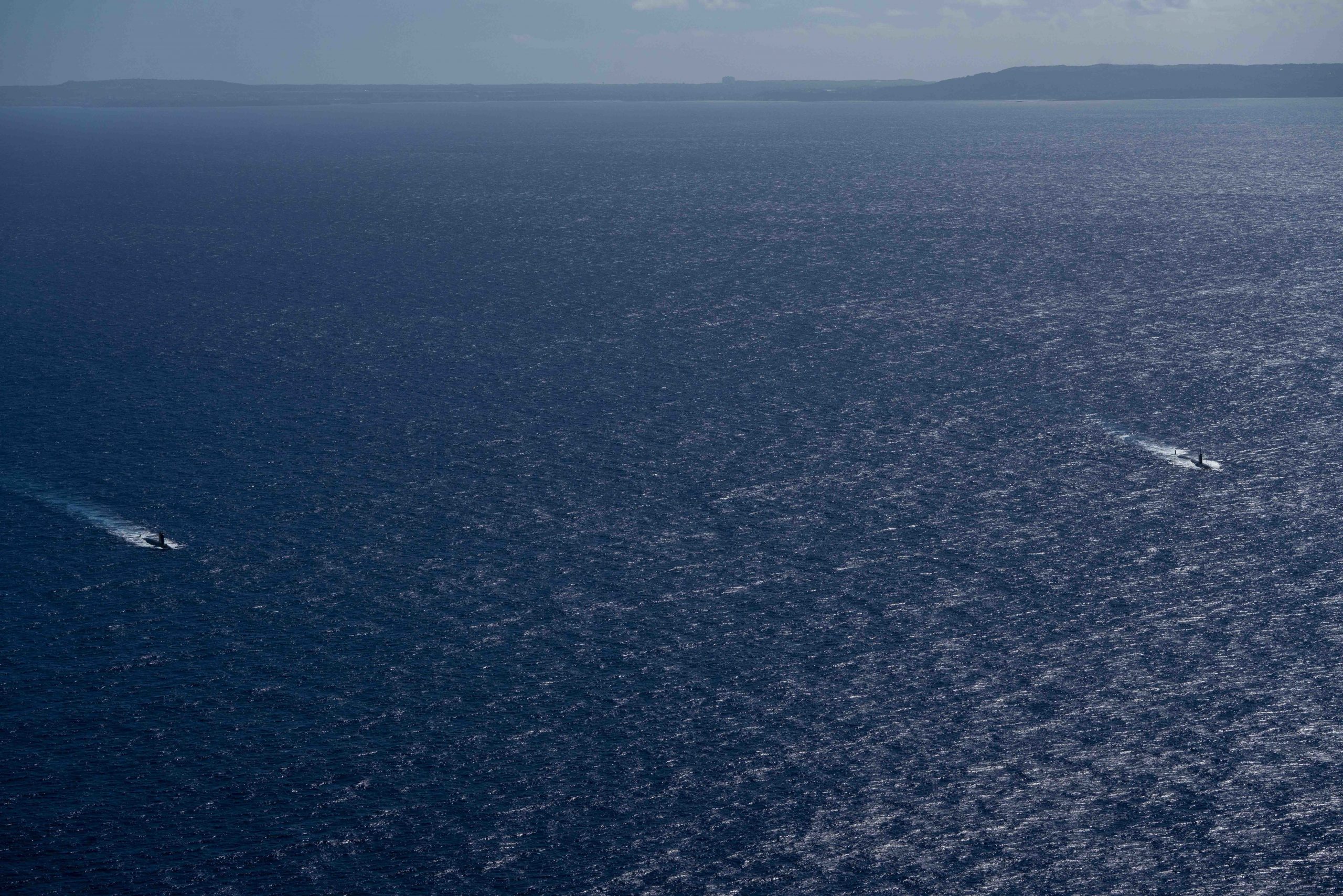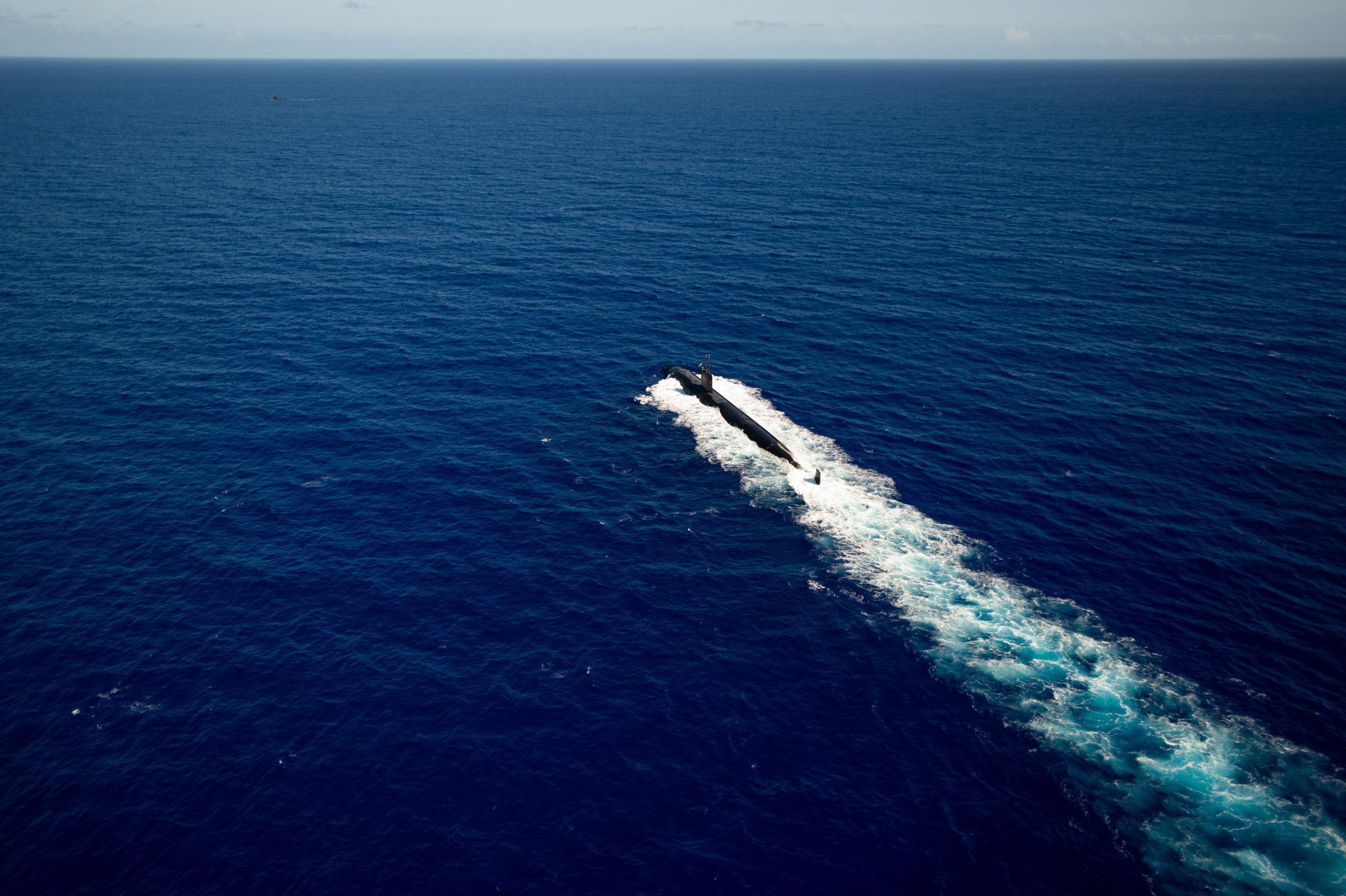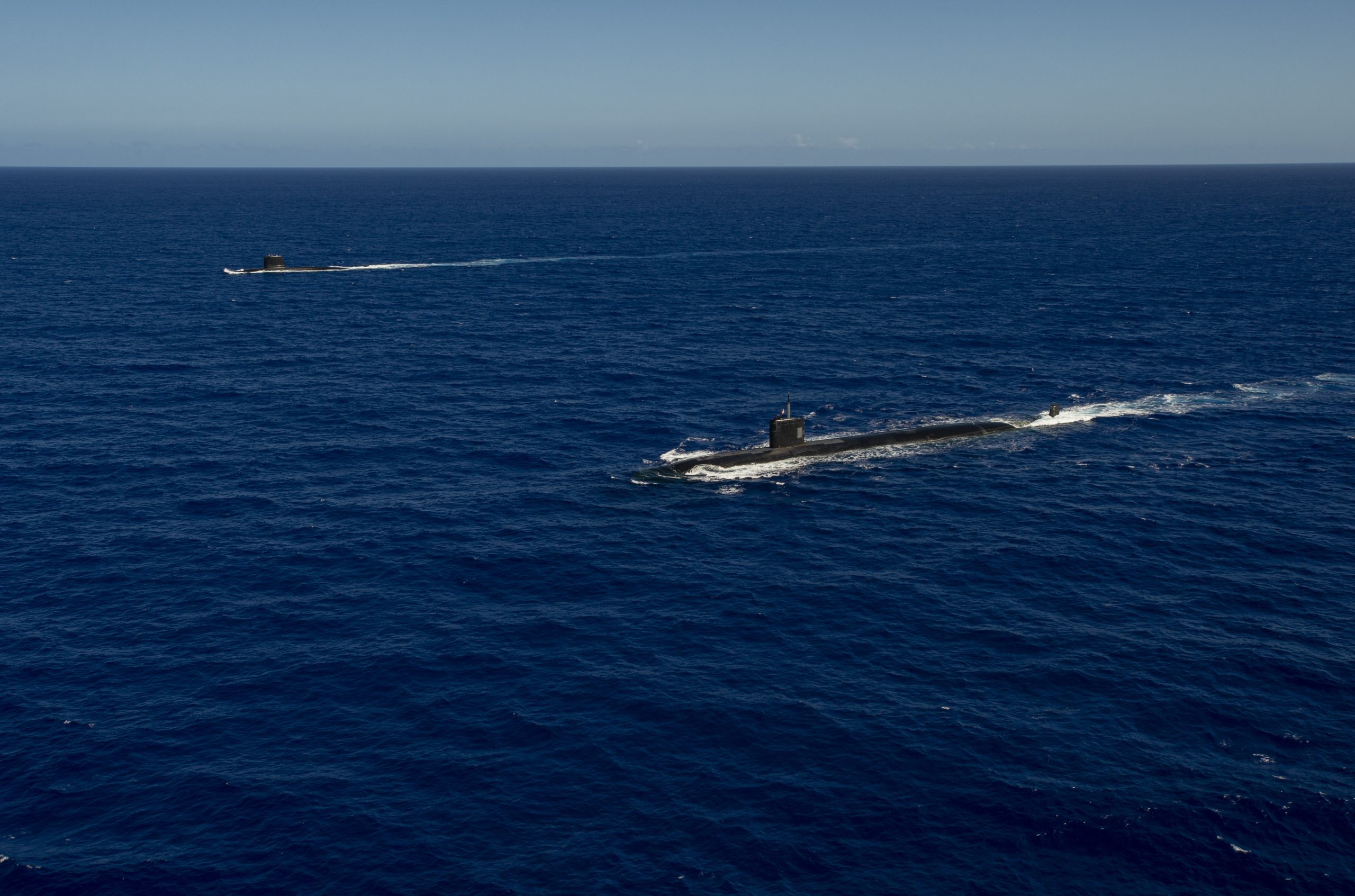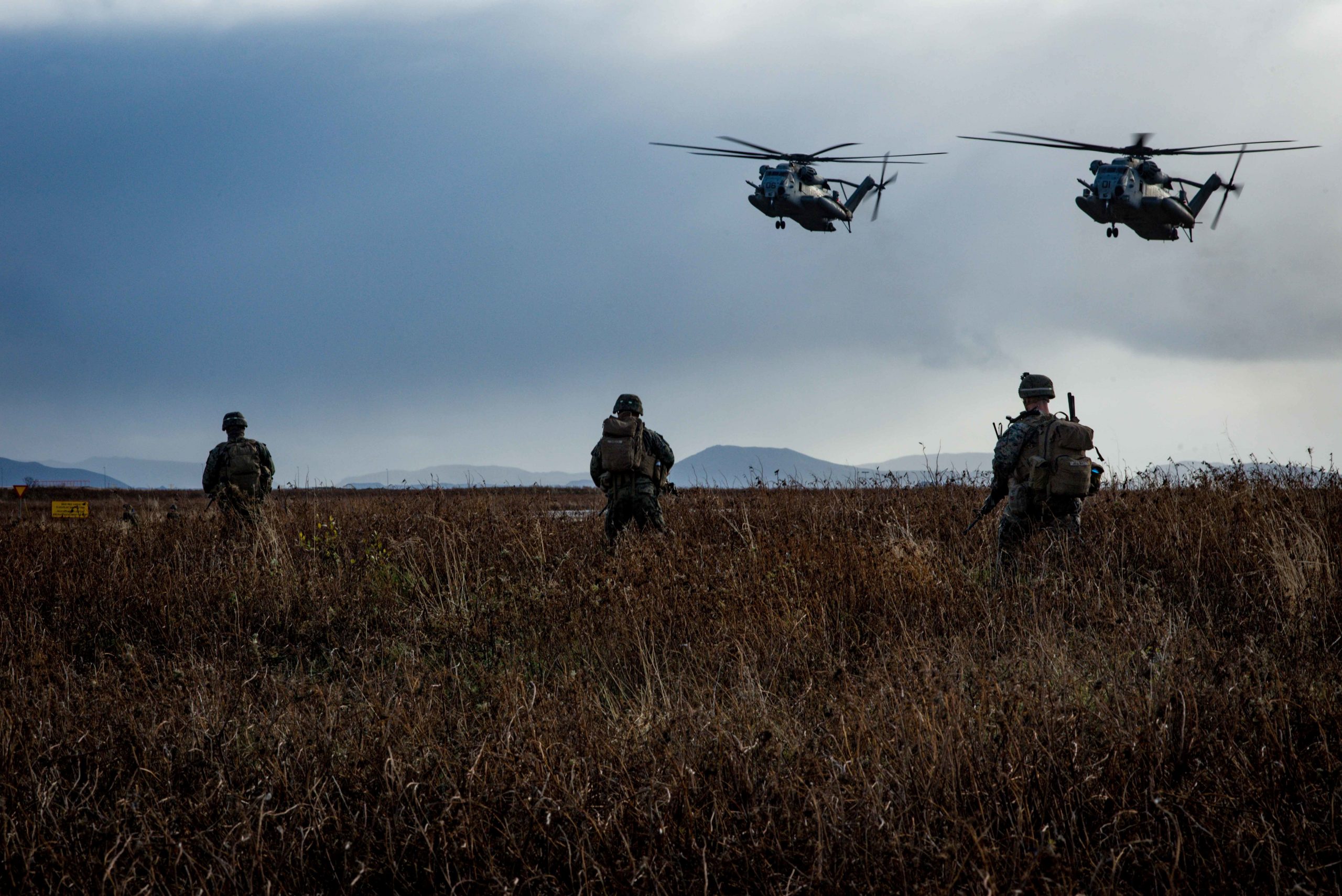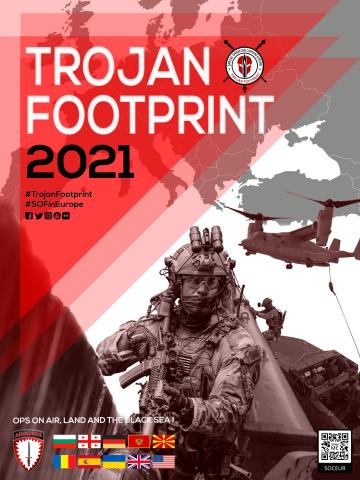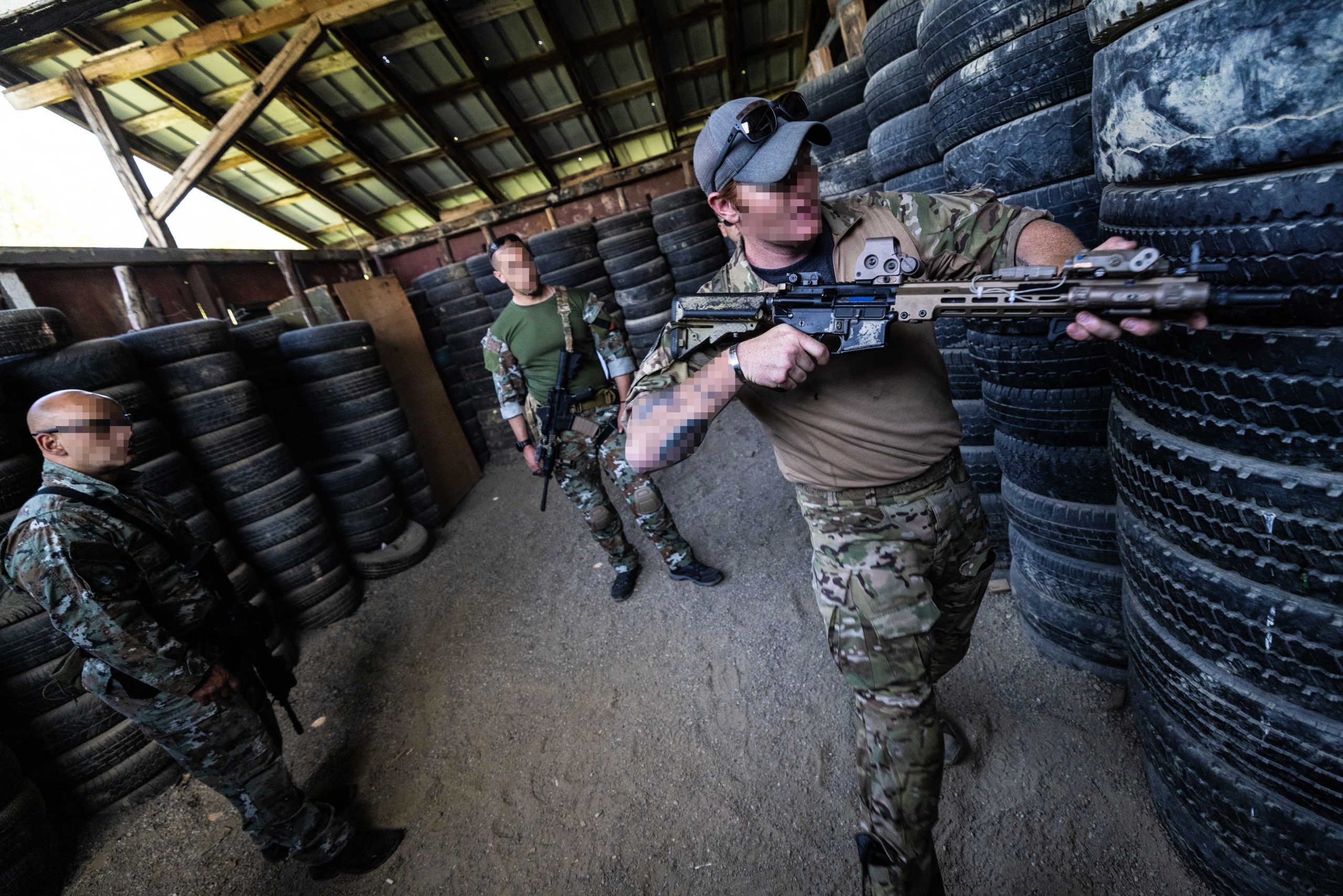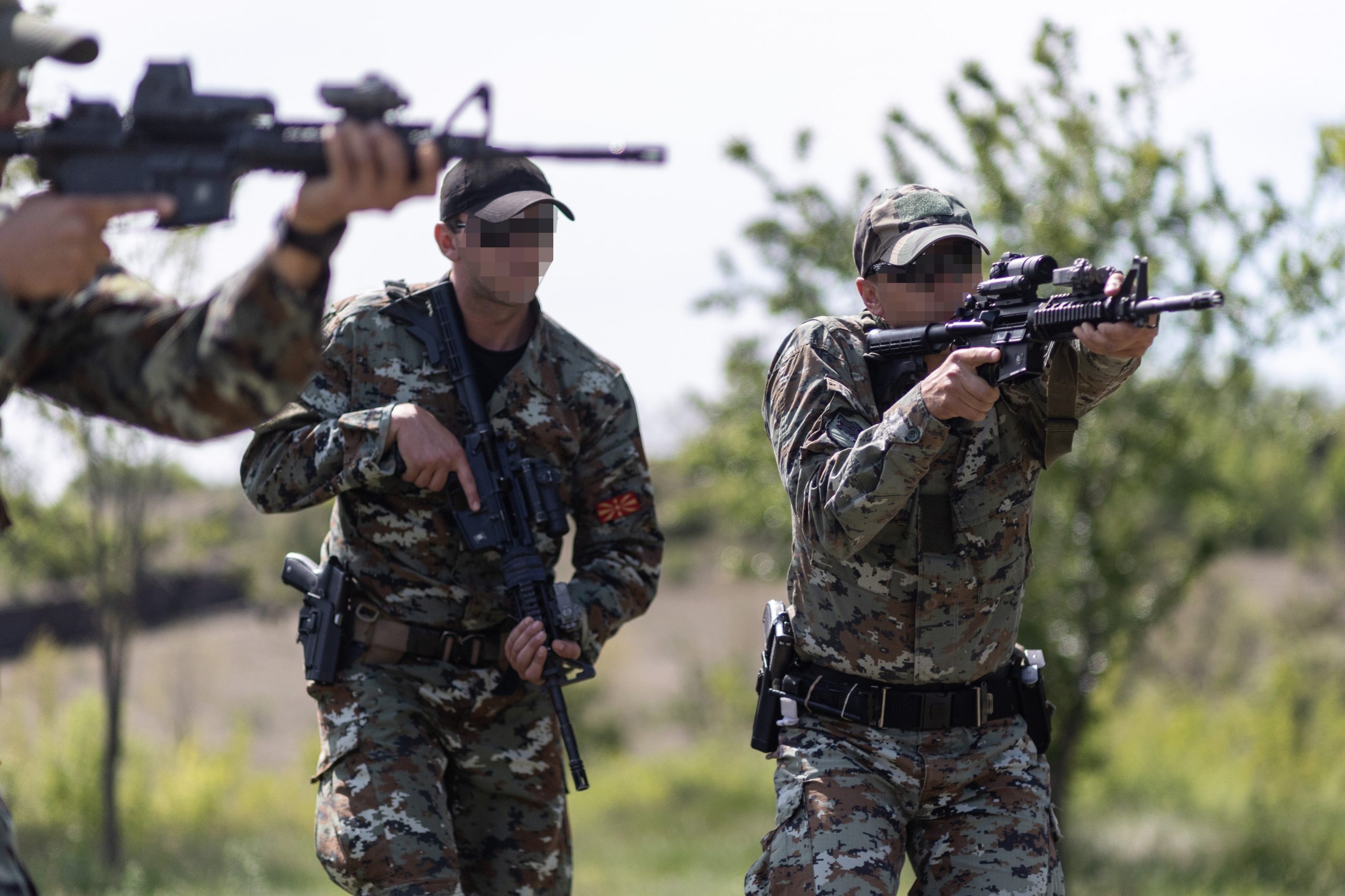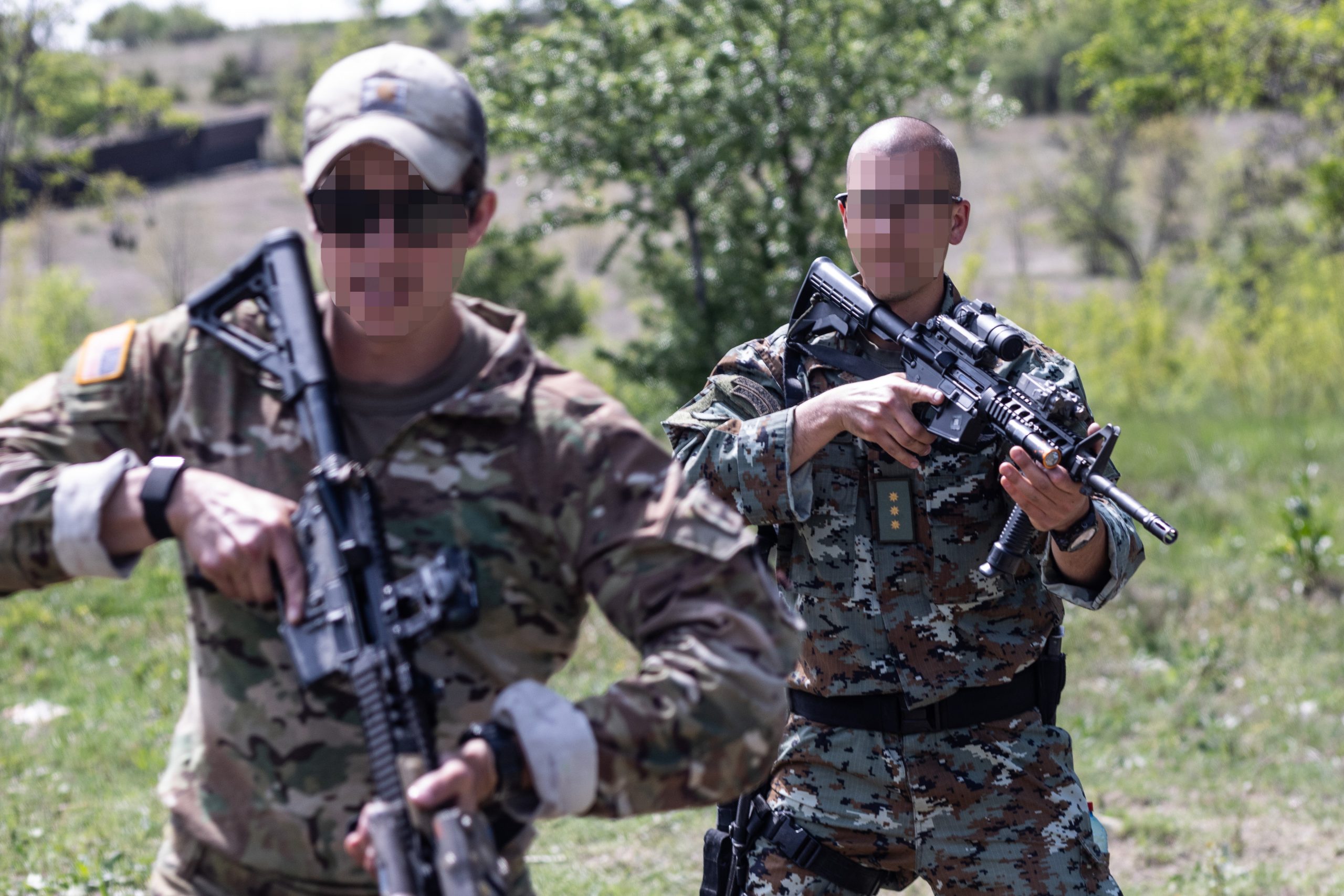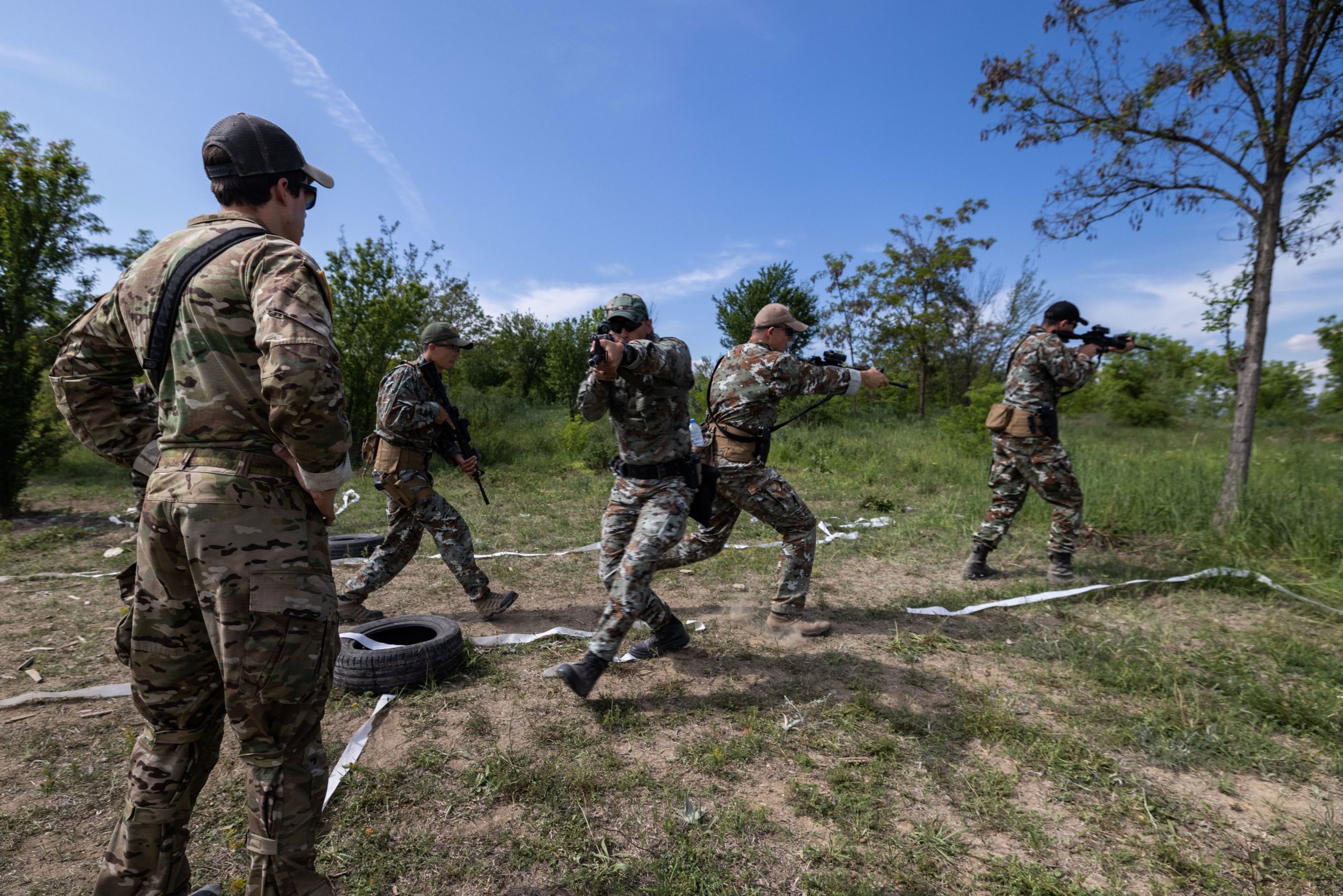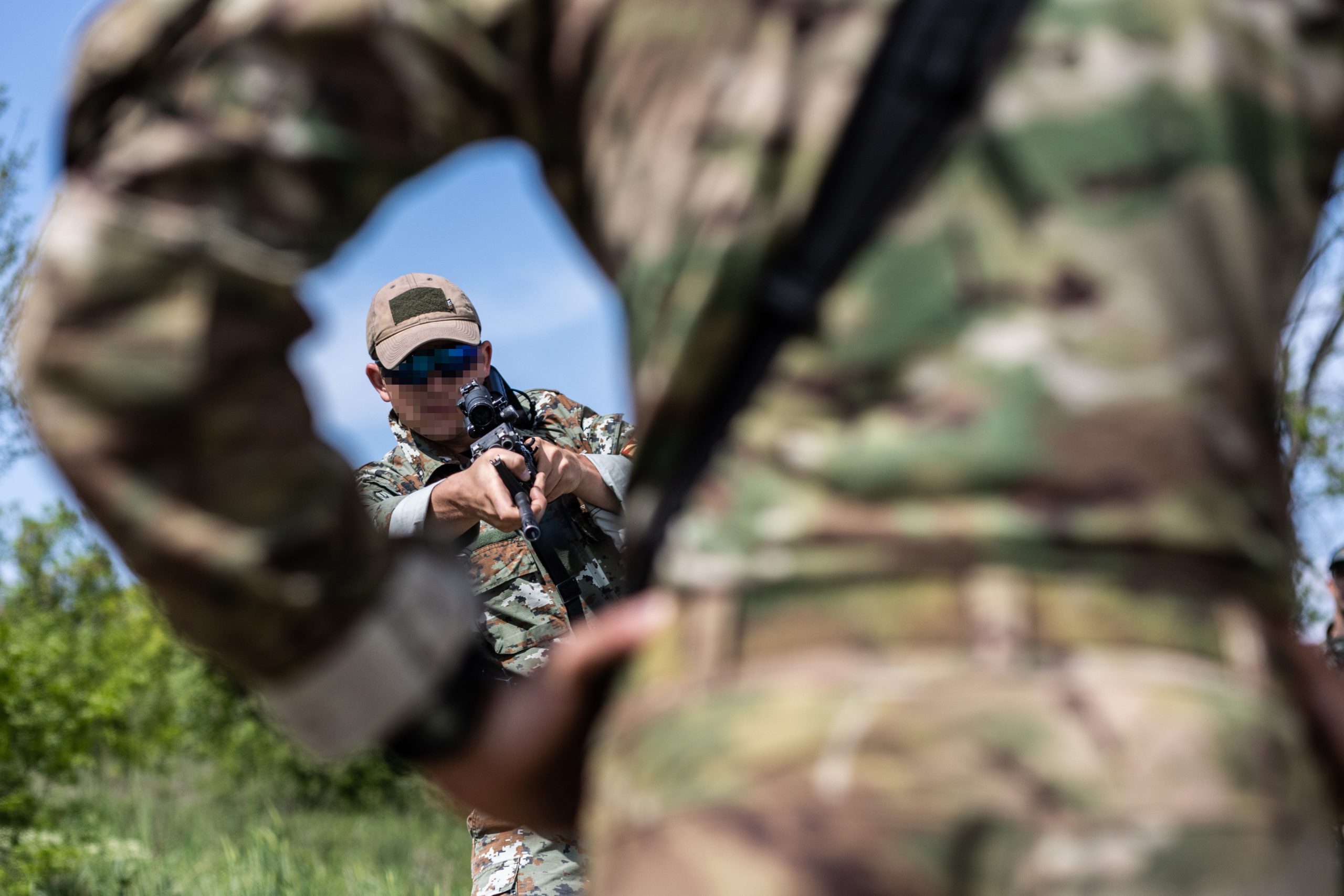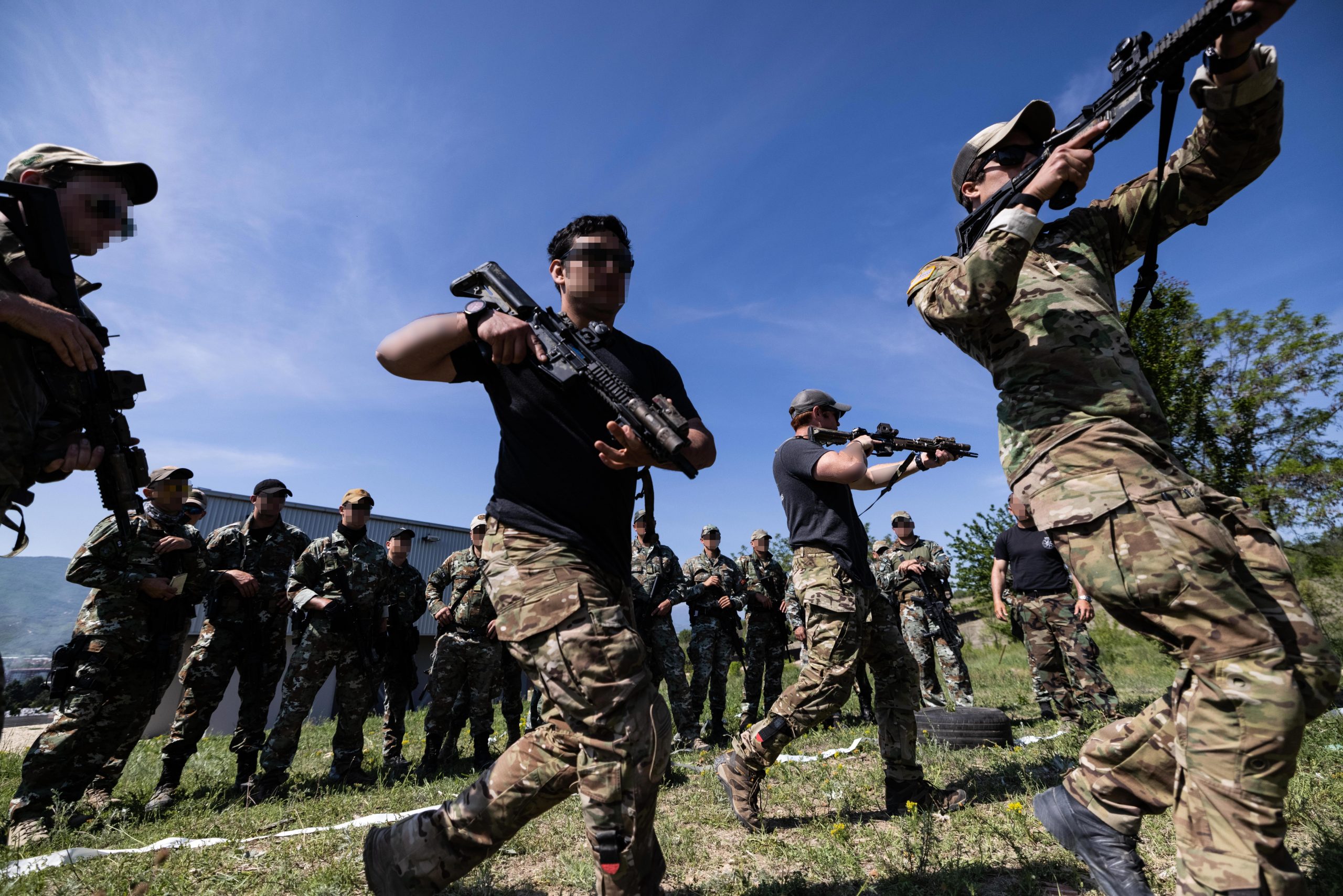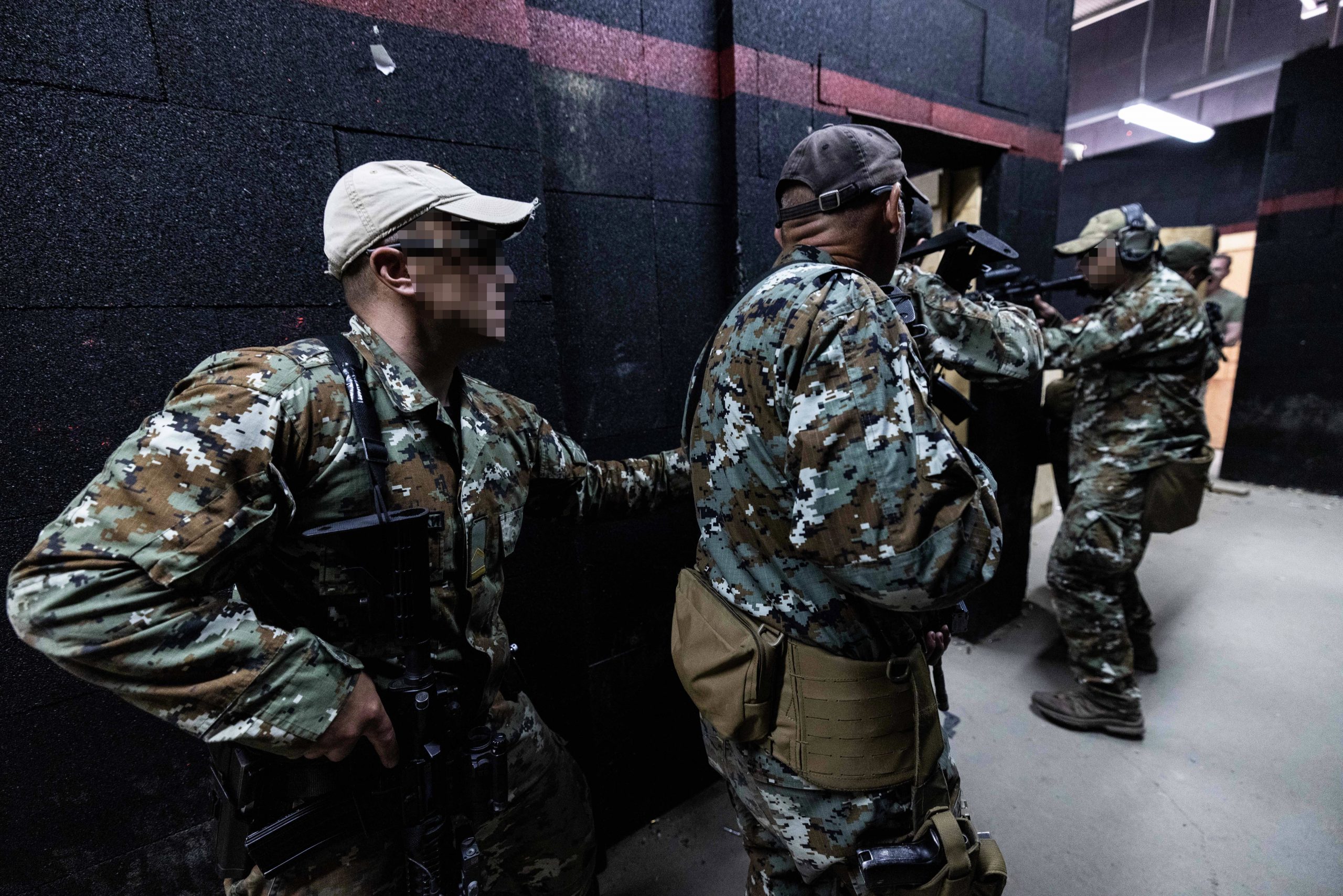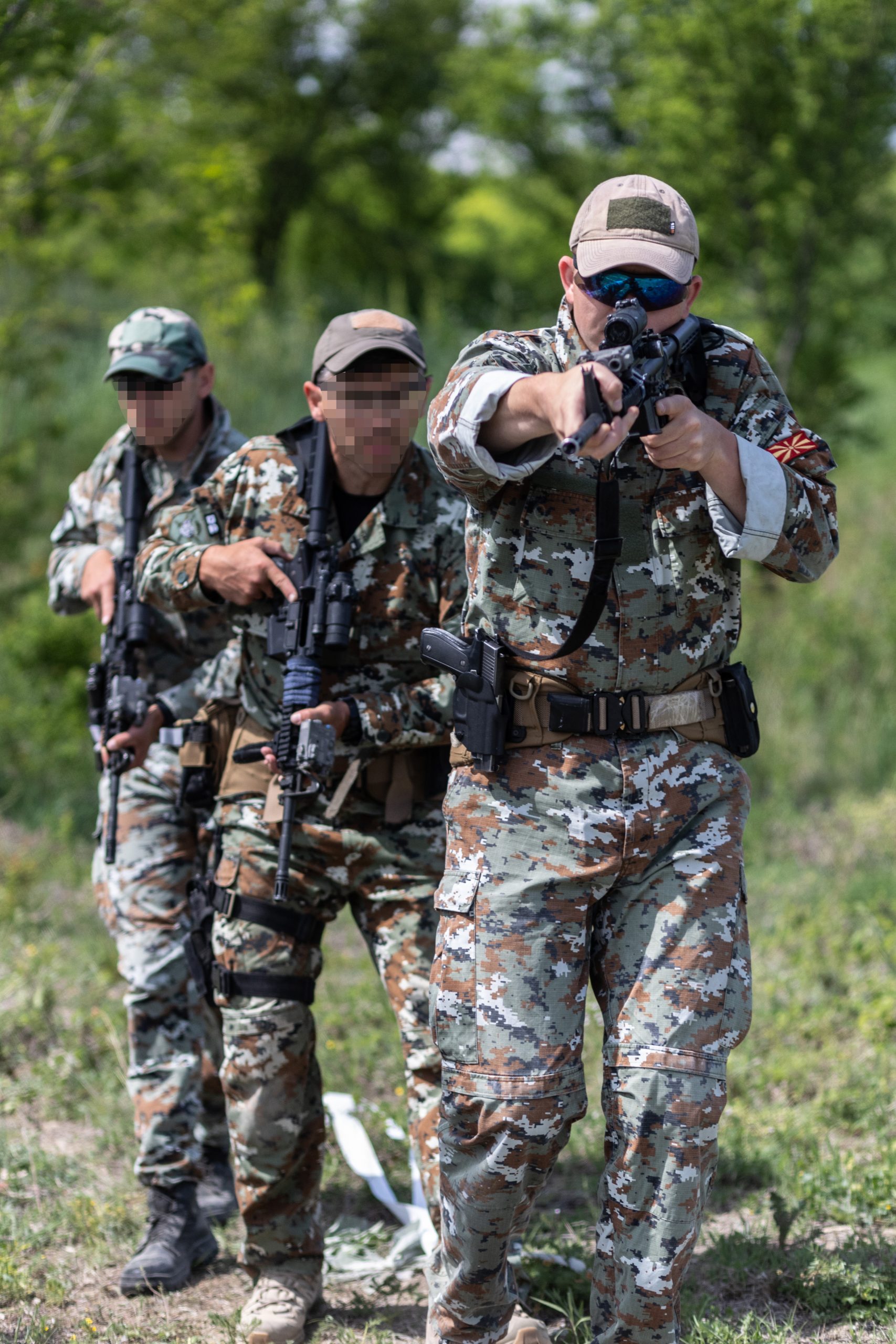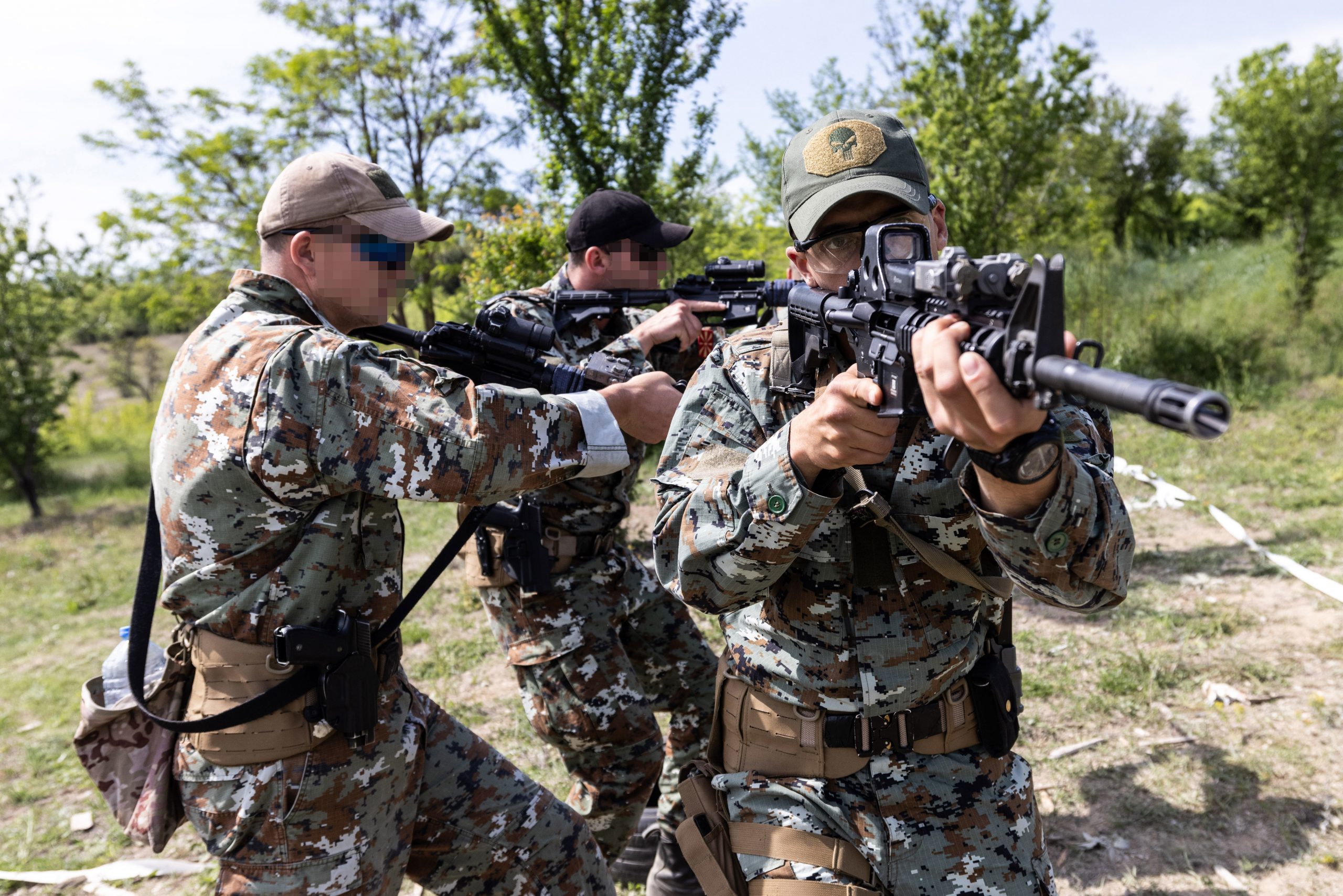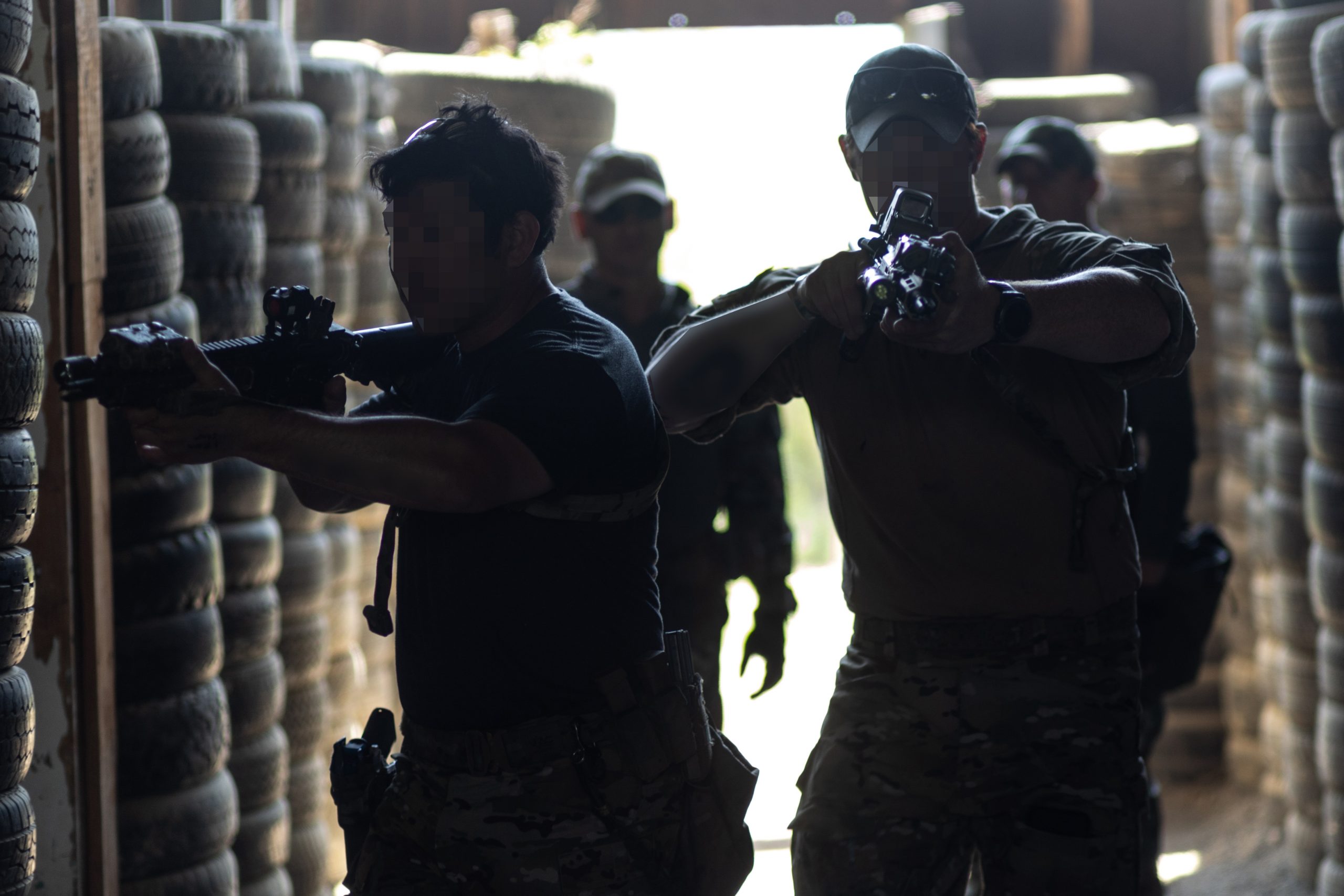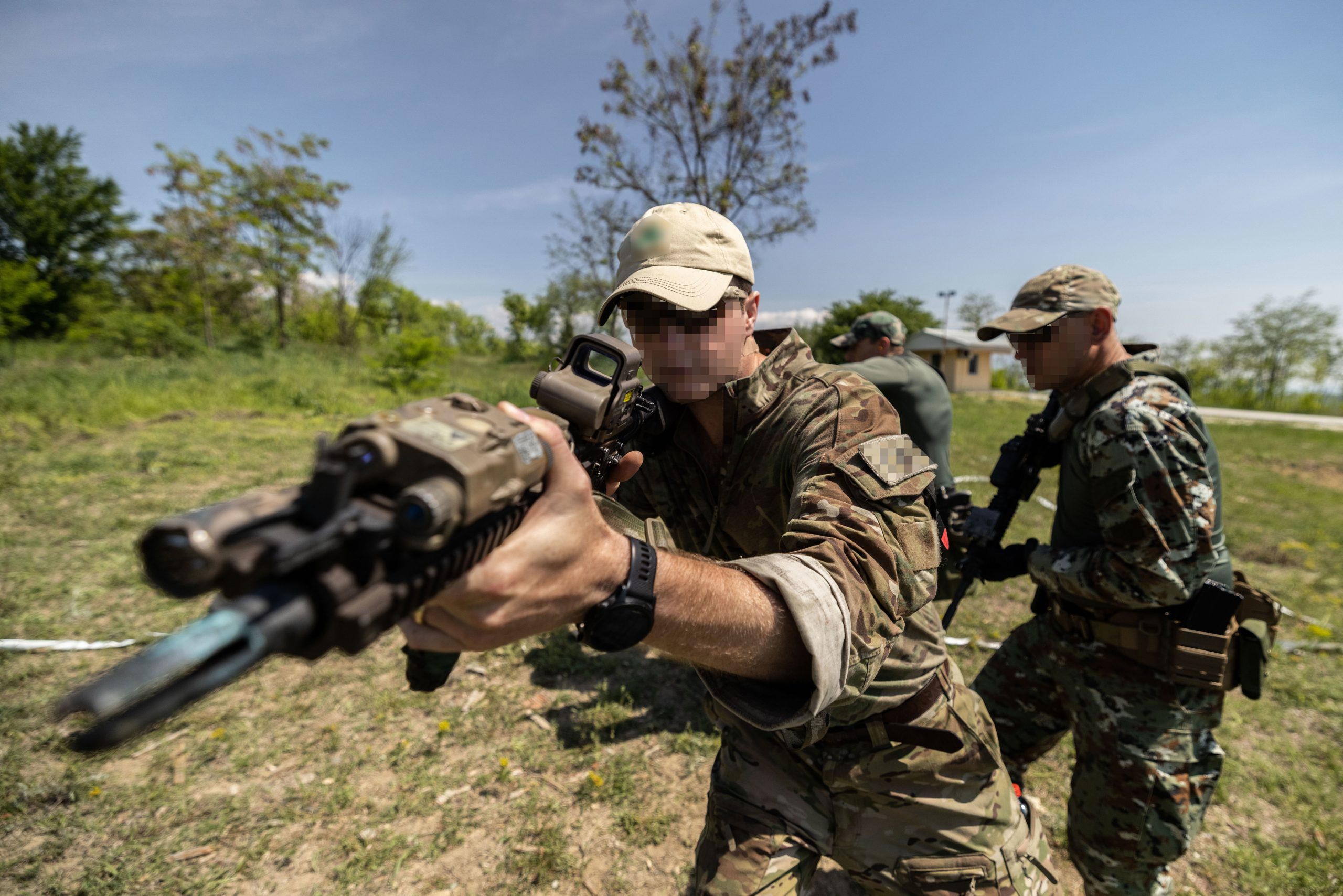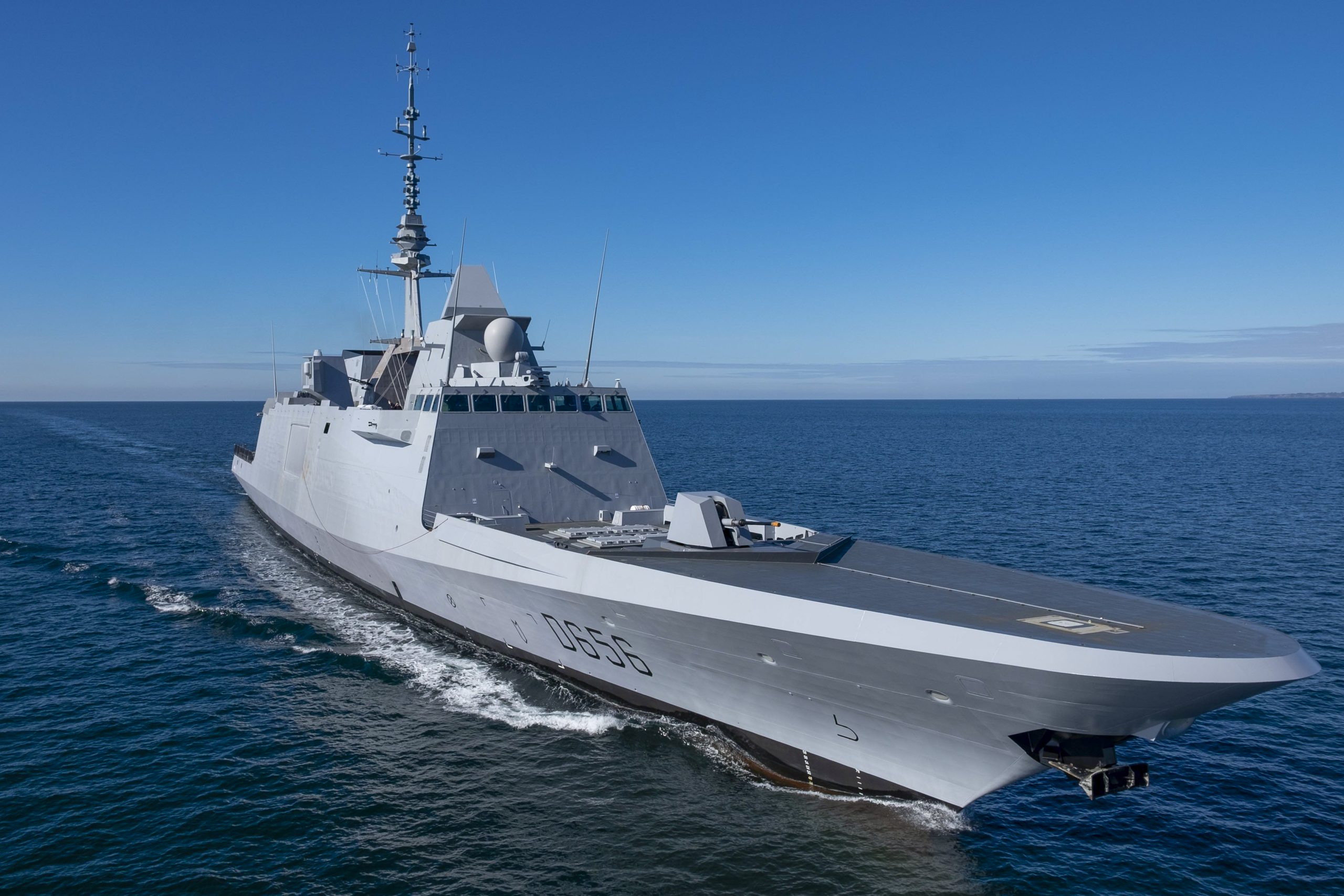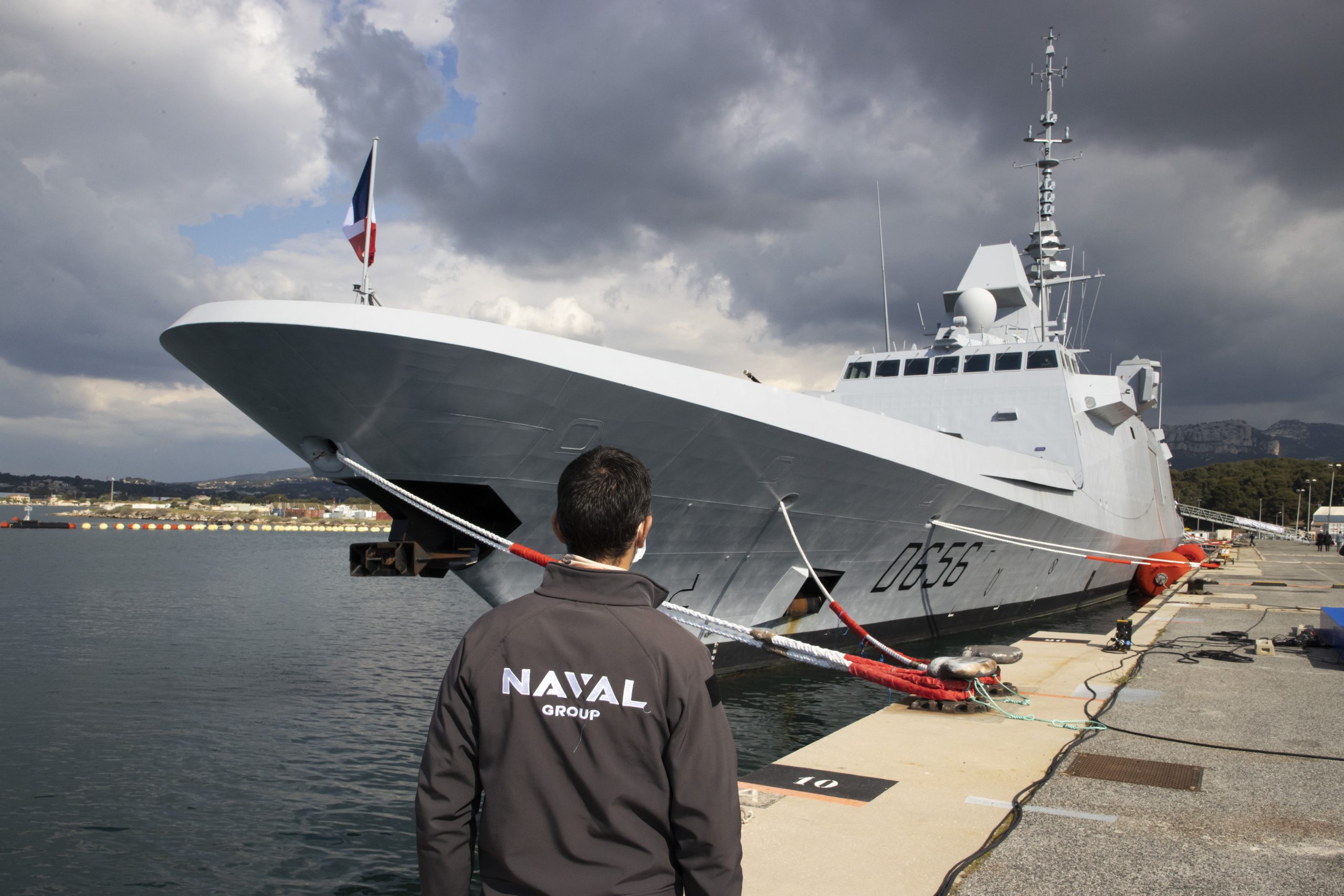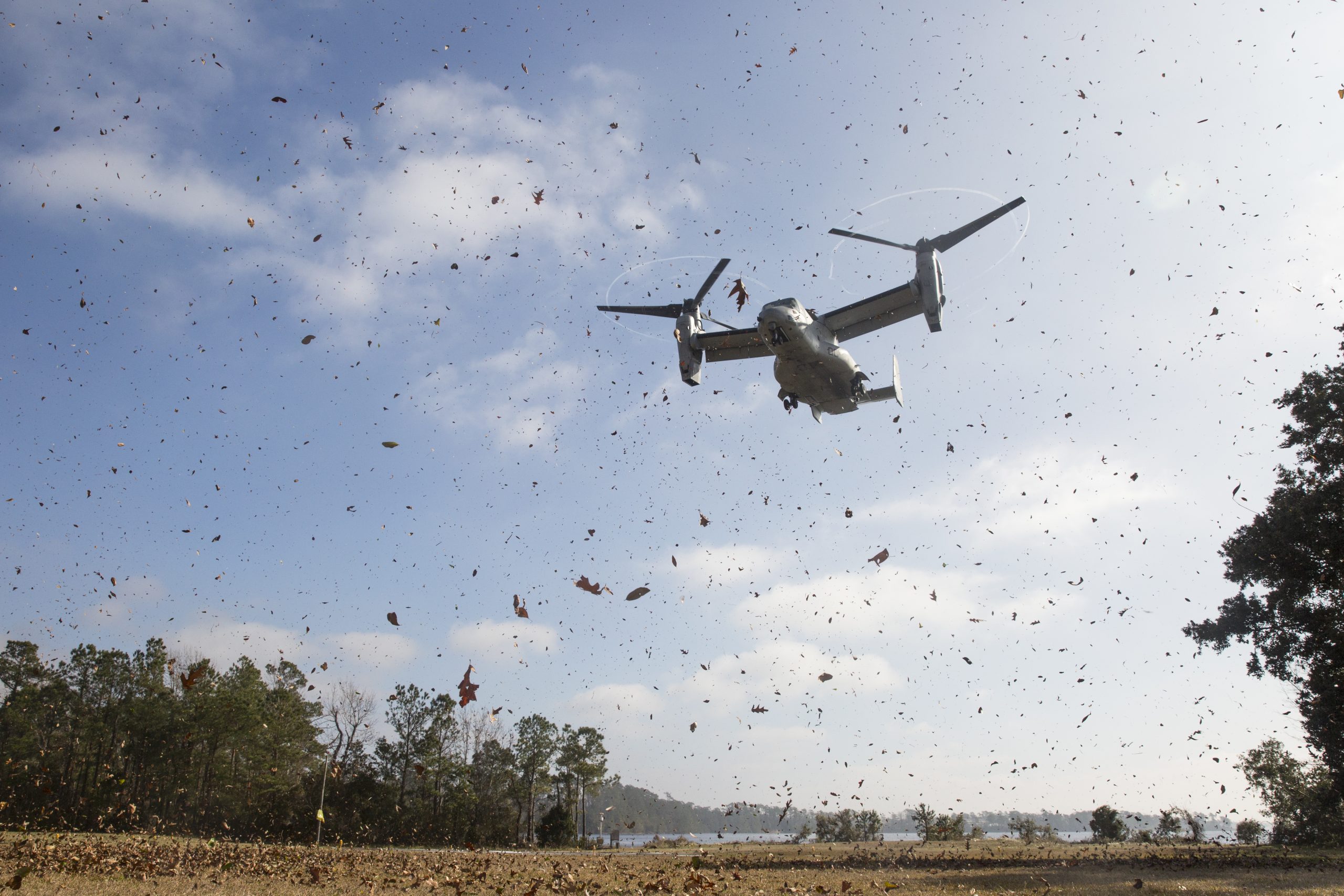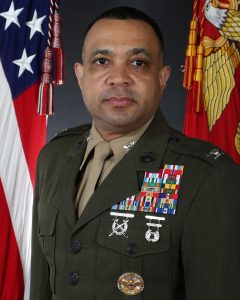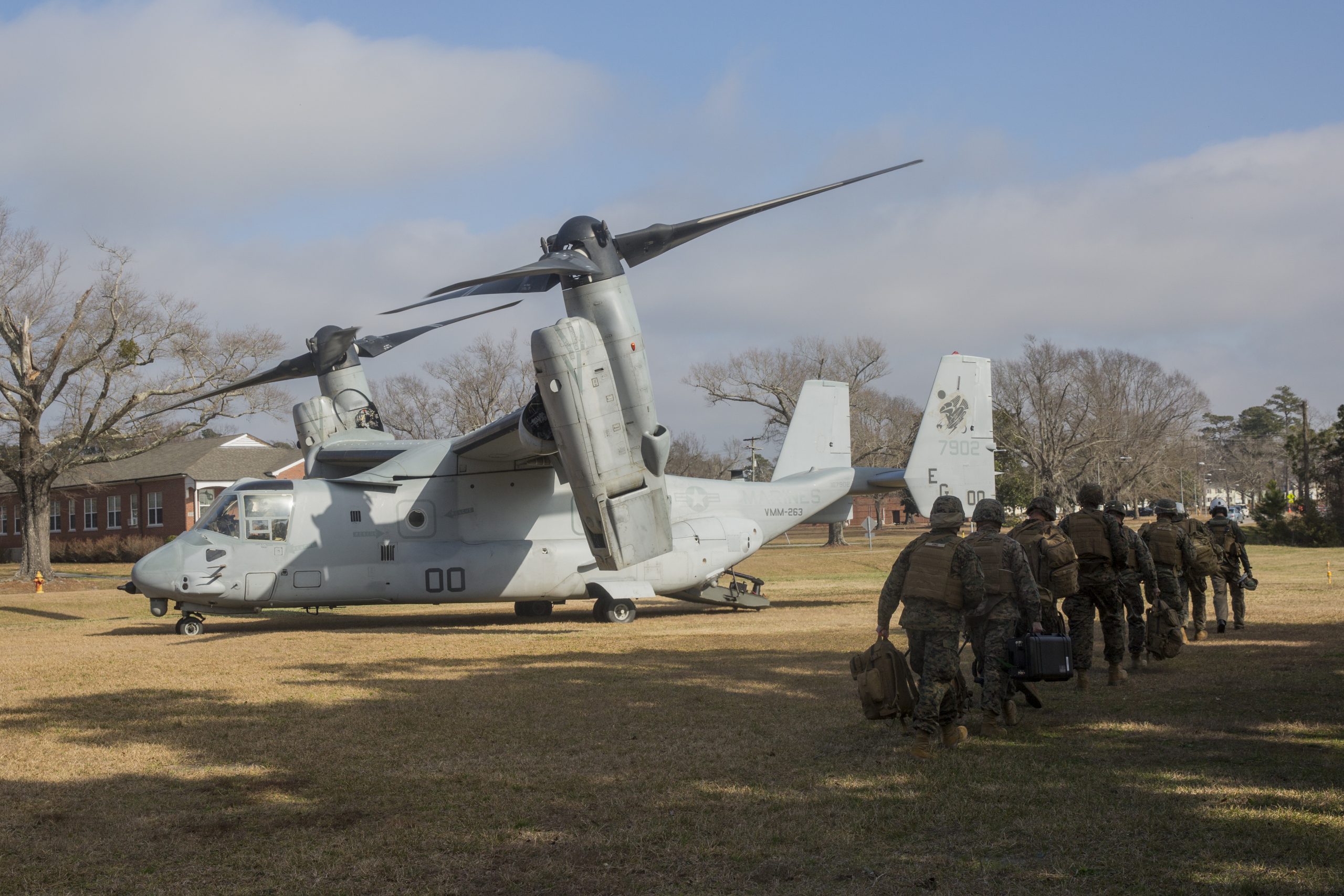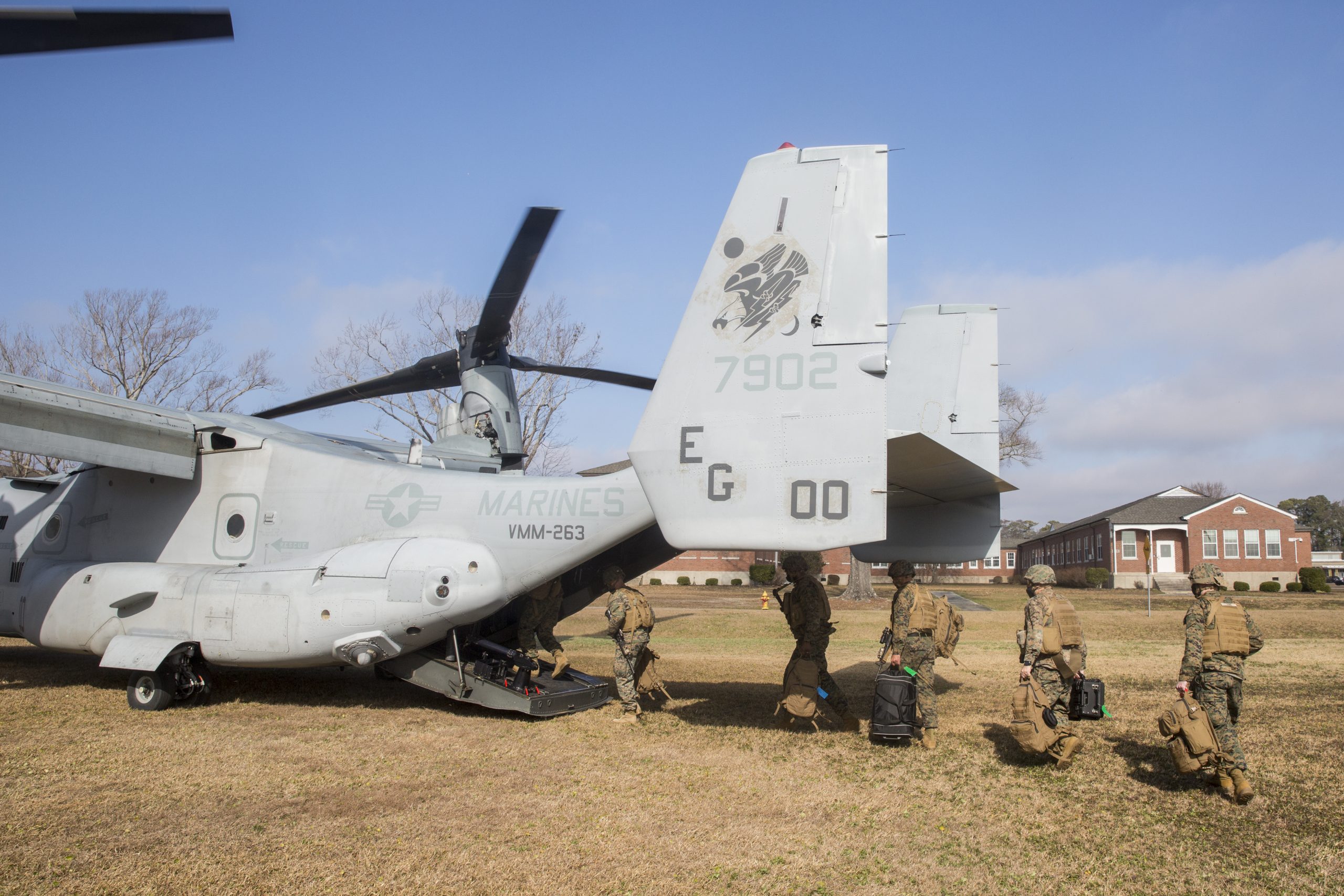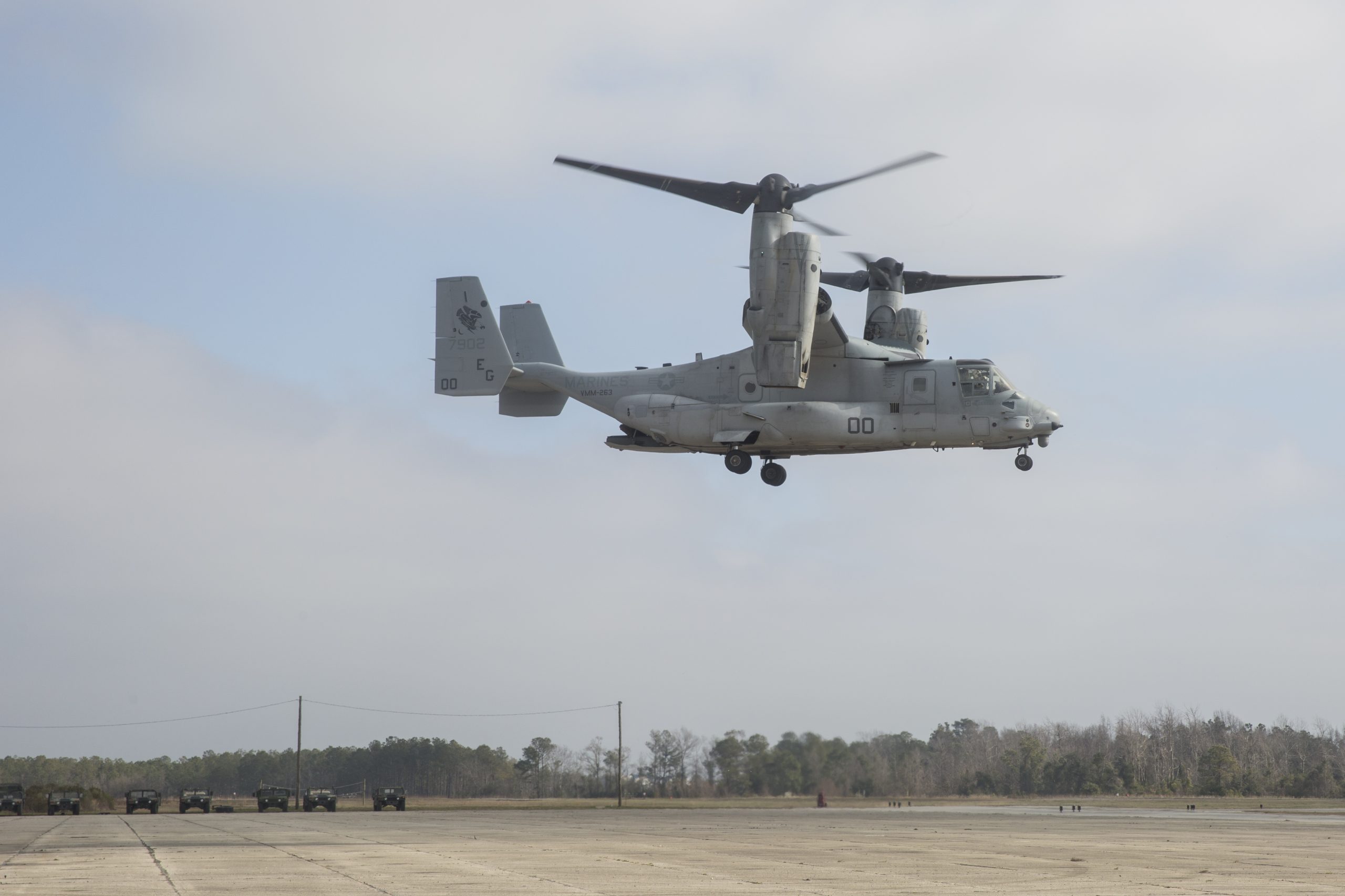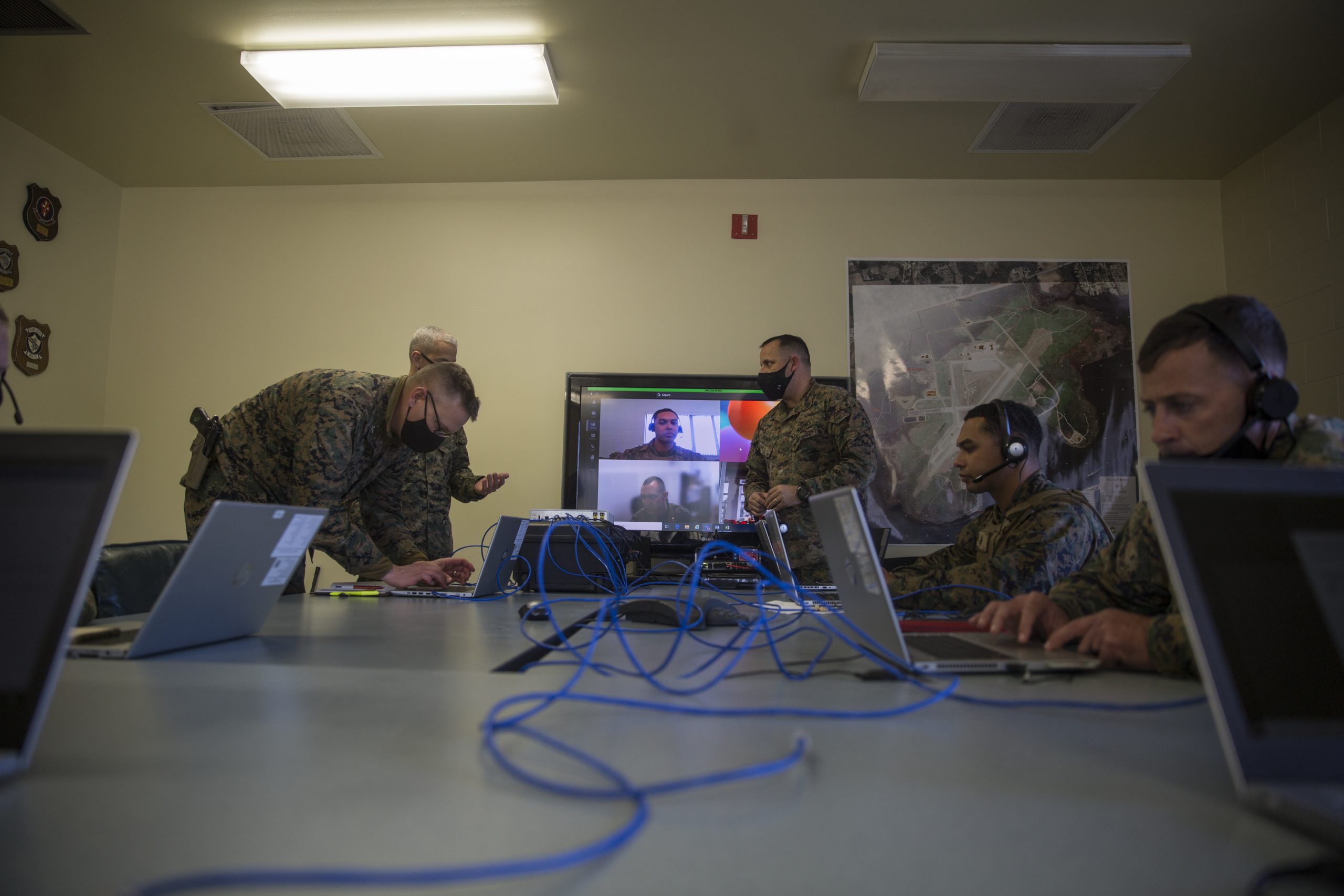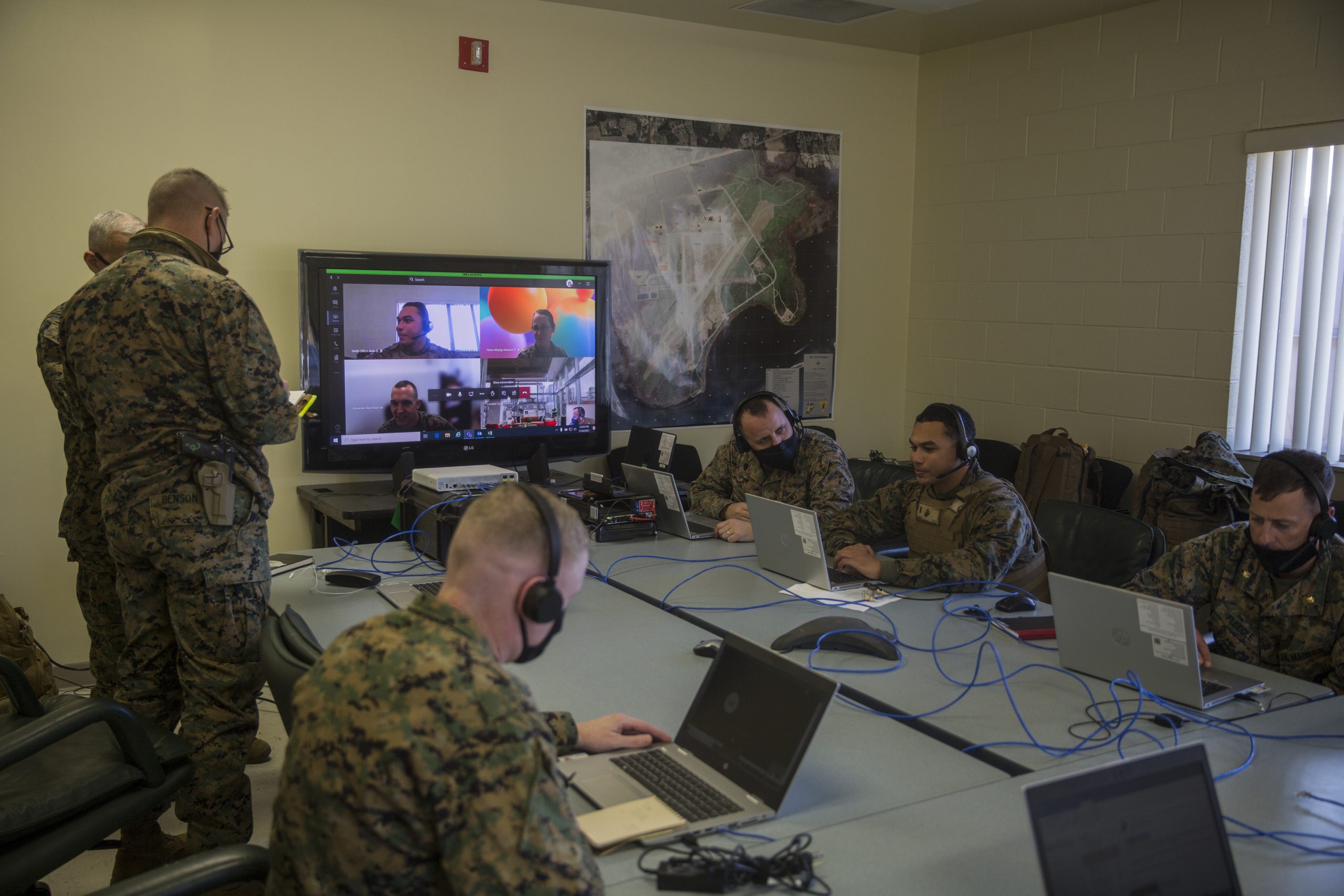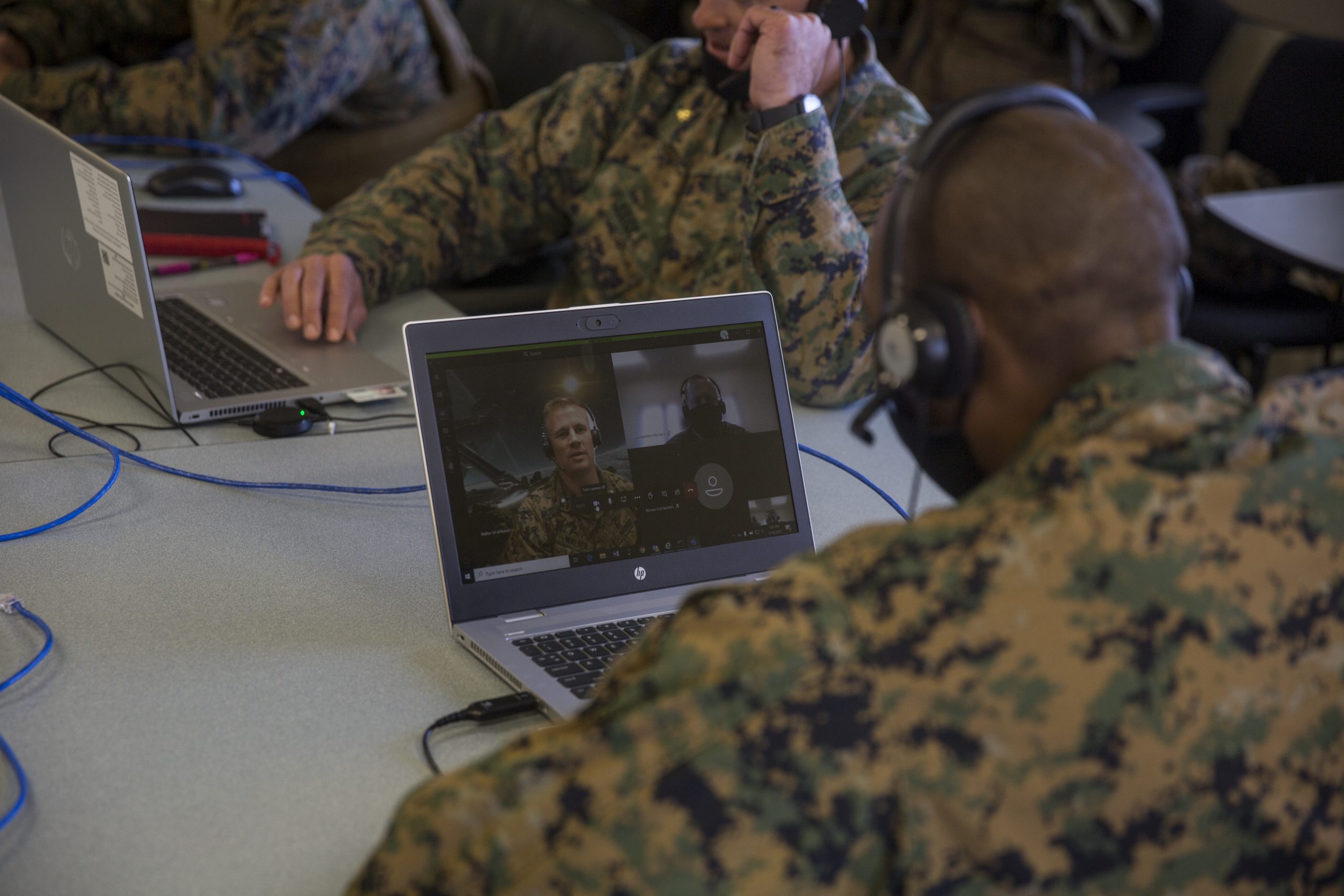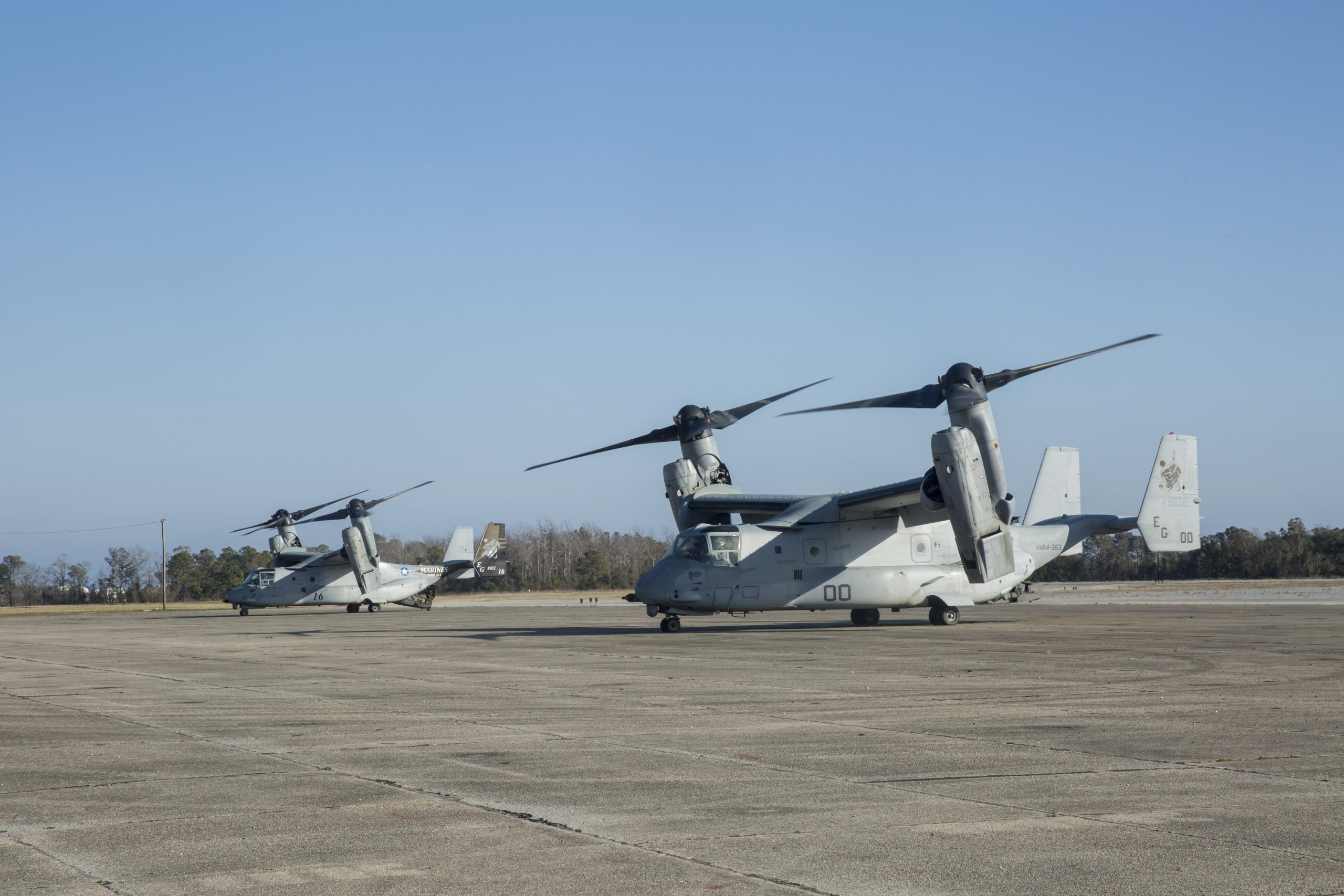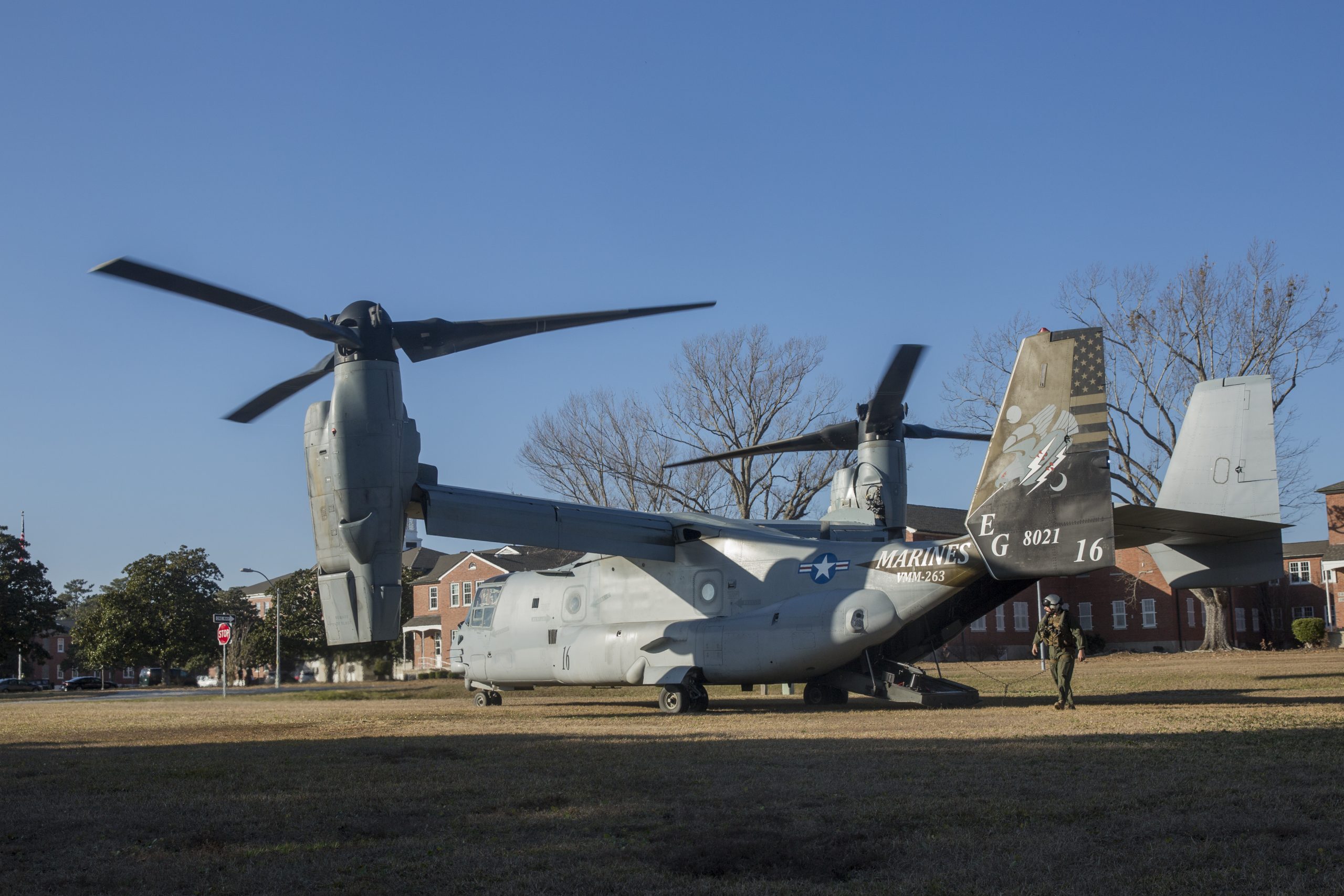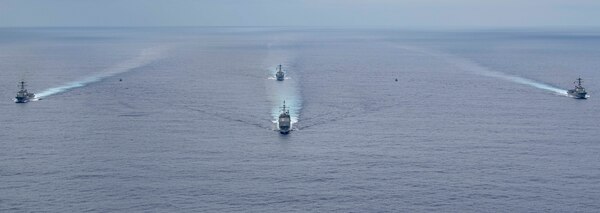By Robbin Laird and Ed Timperlake
With the standing up of Second Fleet in 2018, the stand up of Allied Joint Forces Command and the incorporation of the NATO Centre — Combined Joint Operations from the Sea – it is clear that Vice Admiral Lewis, who oversees all of this, has a clear focus on C2. To do distributed maritime operations or to build an integrated distributed force, one has to build around mission command C2.
This is totally at odds with the last twenty years of war in the Middle East. It is not hierarchical management at the tactical edge; it is about reshaping the force into modular task forces able to function on the basis of mission command and integrated as a coherent fighting unit. And because of the nature of the North Atlantic, this means from the ground up that the U.S. Navy and the sea services must be integratable with allied navies. And this requires training to do so as well as NATO C2 equipment on board.
Because the focus is on the ability to fight tonight, this effort is not about waiting for the optimal 2030 technology solution, which almost certainly will not come in any case. C2F from the beginning of its new life has been focused on how to do distributed C2 with the technology at hand. VADM Lewis has asked a simple but direct question: What can we do now with the technology which exists to deliver enhanced capability for an integrated distributed force?
He has tasked C2F to do this; he has tasked CJOS COE to provide a NATO input to how to do this. And at the same time, Lewis has generated the demand set to find ways to do this better with technology that is already out there or could be coming. He has done this in two ways – one with regard to NATO and the CJOS COE which is plugged into ACT’s efforts to look at future warfighting capabilities and one with regard to the Mid-Atlantic Tech bridge and their working with a variety of technology companies to shape solutions relevant to the evolution of the fleet concept of operations.
During our visit to C2F in March 2021, the Command was working an exercise with a distributed command post deployed to Tampa at MacDill AFB. Vice Admiral Lewis was on a visit to NATO Europe, but as he commented when returning, “exercise ran smoothly with the team in place, which underscores the importance of exercising our ability to do the kind of innovative C2 which a distributed maritime force needs to operate with today.”
The Tampa exercises was simply the latest in a series of ongoing distributed C2 exercises, with earlier ones having been done elsewhere, such as in Iceland or at Camp Lejeune (see stories in the appendix to the article below.)
We had a chance to discuss the expeditionary MOC approach with two members of C2F during our visit. Our first discussion was with LCDR Sean McDonnell in his office at the command. He has been in the U.S Navy since 1994 and is the Command’s JICO or Joint Interface Control Officer. Among other things, he works with the Fleet’s Global Command and Control System through which the ships and other C2 nodes connect to provide the commander with the most comprehensive picture that he has to command forces.
With the new C2F, Lewis has been focused as mentioned above on distributed C2 which means that LCDR McDonnell when he joined the command focused on how best to support this Distributed Maritime Operations (DMO) transition. The command is working expeditionary communications as a core capability or a core enabler of the force.
And by opening the aperture to do so, further innovation is enabled to shape a more interactive and integrated distributed force working with allies as well. A key task which has focused his attention is upon getting the US Navy more capable of working in an integrated manner with NATO European navies. He noted that “we are making significant progress In U.S. Navy assets communicating early and often over NATO networks and we have just installed BICES installed in our office.” BICES is NATO’s version of SIPRNET.
C2F is clearly focused on getting U.S. Navy strike groups much more familiar with NATO procedures as well. He noted that the COMPTUEX exercises (CSG-4) are “now including a NATO vignette where the strike groups have a BICES computer at their battle watch captain station, through which they give updates and communicate regularly with simulated NATO European fleet forces.”
Our next conversation was with Captain Craig Bangor over the phone for he was deployed to Tampa for the C2 exercise. Captain Bangor was one of the very first members of the new C2F and was tasked by VADM Lewis from the outset to work the kind of C2 innovation he was looking for in the fleet.
As Captain Bangor: “C2 has become a bureaucracy unto itself. We focused on the outset on ways to unify the fleet in the Atlantic that could be distributed, work closely with allies, and be very integratable given the demands or the tasks.”
He argued that “expeditionary C2 is a key tool we need in the tool box; it is not just sitting back somewhere and watching the show. We need to have intimate feedback from the commanders who are actually doing the work and expeditionary C2 allows me to have a much more effective force.”
For the C2F team, then doing the C2 piece from the beginning is really a key effort. As Captain Bangor noted: “We need to have the ability to have C2 deployed to where it needs to go; and able to be well positioned to take advantage of adversary actions because the commanders that are doing the fighting can be enabled by the most effective C2 the fleet can provide. Interactive mission command is a key part of working effective distributed C2.”
A third conversation was with CAPT Troy Denison. CAPT Denison is a Surface Warfare Officer and was the XO and then the Commander of the USS Truxtun (DDG 103) for three years from 2016-2018. Denison enlisted in the Navy in 1993 and became a commissioned officer in 1999 after graduating from the Virginia Military Institute.
Captain Denison provided significant insights into how working C2 differently allowed for what we have referred to more flexible modular task force operations. He noted that in 2019, the USS Normandy led a four-ship task force into the High North. This task force did not operate with organic U.S. counter air from a U.S. aircraft carrier, but allies provided such air cover as part of the integration effort.
The tie between a mobile command center and the deployment was evident.
The four vessels, the Ticonderoga-class guided-missile cruiser USS Normandy and Arleigh Burke-class guided-missile destroyers USS Lassen, USS Forrest Sherman, and USS Farragut and a helicopter maritime strike squadron are part of the newly-reactivated U.S. 2nd Fleet intended to counter Russian activity in the Arctic and North Atlantic.
The vessels sailed from their home base in Mayport, Florida earlier this month and on arrival formed a Surface Action Group.
As the 2nd Fleet does not have any permanent operations center in Europe, around 30 of its staff set up a temporary Maritime Operations Center in Keflavik, Iceland, which will coordinate the SAG’s activity…..
“Iceland is a key ally, and its strategic location in the North Atlantic provides a perfect opportunity to test out our expeditionary MOC for the first time,” confirmed Vice Adm. Andrew Lewis, the commander of 2nd Fleet. “Operating out of Iceland reinforces our partnership while allowing us to practice operating in an expeditionary manner and test our ability to surge forward.”
Captain Denison noted that the deployment in 2019 was more by accident than design as the Truman was not available. But now they are focused on deliberate ways to design different types of task forces, which of course, works effectively with C2 as a key enabler.
It was clear in discussing the high north experience from this exercise and other developments, that working the High North with core allies or what Rear Admiral Betton calls the “relevant nations” allows for shaping of new paradigm of collaboration. The logistics and communications challenges, just to mention two of those challenges, certainly drives thinking through new ways to collaborate and to operate in the region.
We discussed this more fully with a fourth officer during our visit, CDR Shaun Servaes. He arrived at the beginning of the standup of C2F and was immediately tasked to work on the BALTOPS Exercise held in 2018. BALTOPS was the first exercise to be managed by C2F and this put them in the thick of a key part of the North Atlantic region affected by the return of Russia as a direct military threat to Europe. They embarked on the USS Mount Whitney to work the C2 part of the exercise and did so with significant NATO participation. So the first exercise presaged what was to come for C2F. The bulk of the force was provided by NATO, not the United States.
CDR Servaes underscored that the BALTOPS exercise underscored priorities for VADM Lewis in the initial standup of C2F. “Admiral Lewis has said since the beginning, he wants to integrate the Marine Corps with naval forces, basically be one force. He wanted to demonstrate as well that the US command element could command subordinate forces that were offered from other nations, as well as embarking international command elements with us. Our deputy commander was a UK commander of the taskforce.”
We then went on to discuss the challenge of shaping an effective U.S. and Allied high north force. Here the logistics challenges are formidable. As CDR Servaes underscored: “If you look from St. John’s, Canada, which is the last place we can get gas heading north, go touch the Arctic Circle and come back to St. John’s it is a longer transit than from San Diego to Pearl Harbor, which is the longest transit we have in the Pacific.” Obviously, to address these challenges allied has to be built in from the ground up and with it an effective C2 structure.
In other words, the command is a warfighting weapon. Its value is driven by how the fleet can integrate across the combined air-maritime forces operated by NATO nations across the domain of the Atlantic. And this is about 360-degree defense operations, inclusive of undersea assets as well as space assets. It really is a kill web approach built around a comprehensive focus on C2, mission command, and an open aperture to encompass the best of new C2 technologies and leaving the rest.
By forging C2F as the command element working with Allied JFC, the real-world interaction between national fleets and C2 integration can be worked to ensure the capability to fight to night as well as evolving the template for incorporating new technologies and capabilities into the evolving force.
Appendix
June 2019: Expeditionary Command Post for C2F in Iceland
U.S. 2nd Fleet (C2F) has temporarily established an expeditionary Maritime Operations Center (MOC) in Keflavik, Iceland, to provide the U.S. Naval Forces Europe (NAVEUR) commander an additional ability to lead forces from a forward-operating location.
“I welcome C2F back to the European theater for the second time this year,” said Adm. James G. Foggo III, commander, Naval Forces Europe and Africa. “The additive capacity that 2nd Fleet brings to the European theater when operating forward alongside U.S. 6th Fleet (C6F) contributes to the overall success of our naval forces’ ability to address challenges and threats to safety and security in the maritime domain.”
The expeditionary MOC, made up of about 30 members of C2F staff, has the ability to command and control forces, provide basic indicators and warnings for situational awareness, and is able to issue orders while maintaining reach-back capability to C2F’s headquarters in Norfolk, Virginia.
“Iceland is a key ally, and its strategic location in the North Atlantic provides a perfect opportunity to test out our expeditionary MOC for the first time,” said Vice Adm. Andrew Lewis, commander, U.S. 2nd Fleet. “Operating out of Iceland reinforces our partnership while allowing us to practice operating in an expeditionary manner and test our ability to surge forward.”
The C2F expeditionary MOC is executing command and control of ships assigned to the recently deployed Surface Action Group (SAG), which is comprised of the Ticonderoga-class guided-missile cruiser USS Normandy (CG 60) and the Arleigh Burke-class guided-missile destroyers USS Lassen (DDG 82), USS Forrest Sherman (DDG 98), and USS Farragut (DDG 99), as well as embarked aircraft from Helicopter Maritime Strike Squadron (HSM) 72.
While in the Atlantic, the SAG is operating in support of naval operations to maintain maritime stability and security, deter aggression, and defend U.S., allied, and partner interests.
C2F’s temporary operations out of Keflavik mark the second time the new fleet has operated at a forward location. C2F first demonstrated this expeditionary capability through command and control of exercise Baltic Operations (BALTOPS) in June 2019, when the majority of its staff embarked USS Mount Whitney (LCC 20).
“Successful operations in the Arctic require practice, and we will take the lessons learned from this deployment to further refine the expeditionary MOC concept for future operations in the North Atlantic and Arctic regions,” said Capt. Chris Slattery, director, C2F expeditionary MOC.
The expeditionary MOC concept is scalable and temporary in nature. While the C2F expeditionary MOC is currently operating out of Iceland, there is no predetermined or permanent operating location in the European theater.
C2F exercises operational and administrative authorities over assigned ships, aircraft, and landing forces on the East Coast and the Atlantic. When directed, C2F conducts exercises and operations within the U.S. European Command AOR as an expeditionary fleet, providing NAVEUR an additional maneuver arm to operate forces dynamically in theater.
U.S. 2nd Fleet Commands Naval Forces from Camp Lejeune
JACKSONVILLE, North Carolina (NNS) — U.S. 2nd Fleet (C2F) has established an expeditionary Maritime Operations Center (MOC) at Camp Lejeune in Jacksonville, North Carolina.
This expeditionary MOC, made up of approximately 30 members of C2F staff, has the ability to command and control forces, provide basic indicators and warnings for situational awareness, and be able to issue orders with a reach-back capability to C2F’s headquarters in Norfolk, Va.
Participating naval forces include the Dwight D. Eisenhower Carrier Strike Group (CSG), which is comprised of the Nimitz-class aircraft carrier USS Dwight D. Eisenhower (CVN 69), the guided missile cruisers, USS San Jacinto (CG 56), USS Vella Gulf (CG 72), and the guided-missile destroyers USS Stout (DDG 55), USS James E. Williams (DDG 95), USS Truxton (DDG 103), and more than 6,000 Sailors all stationed a Naval Station Norfolk.
“Camp Lejeune is the ideal location for Navy-Marine Corps integration opportunities,” said Vice Adm. Andrew Lewis, commander U.S. Second Fleet. “For the purpose of this expeditionary MOC, our USMC counterparts are providing C2F with the supplies and equipment essential to the successful execution of this exercise.”
In CNO’s Design for Maintaining Maritime Superiority 2.0, C2F was tasked to be expeditionary— whether from a maritime platform or an austere location. Regularly operating C2F’s expeditionary capability ensures our ability to respond expeditiously and proficiently when called upon.
Maintaining and expanding upon the ability to command and control forces away from headquarters is central to C2F‘s employment of forces in the Atlantic. During this iteration of the expeditionary MOC, II Marine Expeditionary Force assisted with infrastructure development. Both C2F and II MEF will draw lessons learned from this operation to inform future employment of an integrated command and control center in the future.
“We are implementing lessons learned from previous expeditionary MOC operations which will directly influence the way we employ naval forces at the operational level going forward,” said Capt. Craig Bangor, Second Fleet MOC director. “To accomplish our assigned mission this time, we have included intelligence, logistic, cyber, information, and maritime operations and planning capability organic to the expeditionary MOC. While the team in Norfolk is leading and planning for a wide array of operations, our team in Camp Lejeune is solely focusing on the employment of the Eisenhower Strike Group as it crosses the Atlantic utilizing the expeditionary MOC capabilities.”
The expeditionary MOC concept is scalable and temporary in nature, and the iteration in Lejeune marks the third for C2F sing it’s establishment in August, 2018. C2F first demonstrated this expeditionary capability through command and control of Exercise Baltic Operations (BALTOPS) in June 2019 when the majority of staff embarked aboard USS Mount Whitney. Most recently, C2F employed a forward deployed expeditionary MOC in Keflavik Air Base, Iceland.
C2F exercises operational authorities over assigned ships, aircraft, and landing forces on the East Coast and the Atlantic.
02.26.2020
Commander, U.S. 2nd Fleet




